| |||||||
| Search Forums |
| Advanced Search |
| Go to Page... |
 |
| Search this Thread |  1,745,856 views |
| | #1 |
| Team-BHP Support  | Maruti Ignis : Official Review The Maruti Ignis is on sale in India at a price of between Rs. 4.59 - 7.80 lakhs (ex-Delhi). What you'll like: • Unique, funky design - exterior & interior stand out in a crowd. Customisation options available • Smart packaging! Good legroom & headroom in such a small car. Useable 260-liter boot too • Peppy petrol & efficient diesel. What’s more, the AMT automatic is available with both engines • Dual airbags, ABS with EBD and ISOFIX child seat anchors are standard across all variants • Maruti's widespread service network, excellent after-sales support & fuss-free ownership experiences • Features such as LED projector headlamps + DRLs, reversing camera, Apple & Android ICE, navigation, electrically-foldable ORVMs etc. What you won't: • Simply overpriced, not a VFM Maruti. Top trim is especially pricey • You can buy more accomplished cars for the same (Grand i10) or a little more (Baleno) money • Weird rear end styling. Overall, the unconventional looks will polarize opinions • AMT, although improved, still can’t match conventional ATs on smoothness or speed • Narrow cabin width. Rear seat is better for 2 adults than 3 • 32-liter fuel tank is too small for this segment. Even the humble Alto gets a larger tank 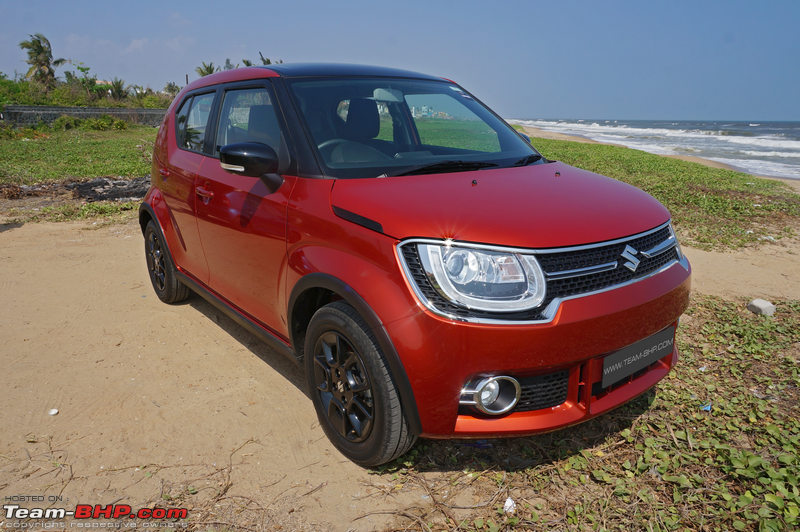 Last edited by GTO : 13th August 2017 at 17:47. Reason: AMT now available in top trim, hence removing that point |
| |  (70)
Thanks (70)
Thanks
|
| The following 70 BHPians Thank Aditya for this useful post: | ach1lles, AdityaDeane, aeroamit, akchd, artemis_fowl, ashishk29, AutoIndian, Avikbrio, blackwasp, CarguyNish, carrazy, deetjohn, dhruvritzed, dr_petrolhead, espraveen, FueledbyFury, Gannu_1, gauravanekar, Grand Drive, GTO, harry10, iliketurtles, InControl, justwheels, Killswitch, KLxpress, Leoshashi, manij, mastercylinder0, mbz180, MDED, MSAneesh, noopster, NPV, Patriot_Vishwas, phynix123, Ponbaarathi, procrj, Rajeevraj, RavenAvi, Redline6800, rohitoasis, romeomidhun, rshanker, Sail, samabhi, samaspire, SchrödingersCar, sdp1975, shancz, Sheel, Shyam96, Simhi, Sip, SmartCat, sri2012, subhro1988, suhaas307, sunny29584, swiftnfurious, The Rationalist, theexperthand, uday.ere, v12, vaasu, vb-saan, Vik0728, vikred, vishy76, WAM-4 |
| |
| | #2 |
| Team-BHP Support  | Re: Maruti Ignis : Official Review Review Index: Exterior Last edited by Aditya : 16th April 2017 at 10:38. |
| |  (19)
Thanks (19)
Thanks
|
| The following 19 BHPians Thank Aditya for this useful post: | AutoIndian, baby_antu, Gannu_1, GTO, MSAneesh, Patriot_Vishwas, rahul412, Rajeevraj, RavenAvi, romeomidhun, SatishBisht, sdp1975, Sheel, theexperthand, Thunder70, uday.ere, vb-saan, vikred, WAM-4 |
| | #3 |
| Team-BHP Support  | Exterior In India, the B2 segment is the largest share of the pie in terms of sales. Most mass market manufacturers cater to the customer’s requirements in this segment. For a product to succeed in the B2 segment, it has to be modern, well equipped, stylish and backed by a strong service network. Global giants such as Toyota, Ford and Volkswagen have not managed to get the formula right so far. On the other hand, Maruti Suzuki and Hyundai have been able to find the pulse of the buyers with multiple models on offer. Hatchbacks like the Swift, Baleno, Grand i10 and i20 Elite sit right at the top giving customers exactly what they want. Maruti had another car in this segment - the Ritz. While it sold in decent numbers over the years, it was unable to keep up with it’s sibling, the Swift. The Ritz was mechanically identical to the Swift, but offered more practicality with better interior room and boot space. However the quirky styling, especially the rear design did not attract buyers who preferred the more stylish and sportier Swift. To maintain its strong foothold in the segment, Maruti decided to introduce another hatchback - the Ignis. The Ignis is ideally supposed to replace the Ritz as it slots in below the Baleno and Swift internationally. However, unlike the Ritz, the Ignis is being sold through Maruti Suzuki's Nexa dealership network. This means it enjoys premium positioning among the company's offerings and shares showroom space with the S-Cross, Baleno and now Ciaz. One may argue as to why the Ignis needs to be sold through the premium Nexa channel when it’s supposedly a mass market hatchback. We already know that dealers who took a risk by setting up a new showroom were unhappy after the S-Cross. The S-Cross, which was the first Nexa model, was not very successful at drawing crowds and Maruti had to offer huge discounts in an attempt to move stocks. The Baleno’s success injected some life into the Nexa showrooms. While it has turned things around considerably for Nexa, there is no doubt that the dealership network needed more high volume sellers and the Ignis is expected to be one of them. Maruti is trying various marketing strategies with the Ignis by targeting the so called “millennials” and pitching the Ignis as a urban compact vehicle. Since the Ignis replaces the Ritz, we expected it to be priced at par with the outgoing model. But, this is not the case. Being sold through the "premium" Nexa chain has resulted in a higher sticker price than what was expected. This is especially true for the top end Alpha trim, which is simply too expensive. To top it off, Maruti is charging nearly 1.2 lakhs for the diesel engine over the petrol mill. The top-end diesel variant of the Ignis is more expensive than the Swift hatchback, which was earlier positioned above the Ritz in the model line-up. The more competent Baleno parked in the same showroom isn’t too far away in pricing when you look at it in EMI terms. Maruti probably believes the “millennials” have money to spend for a unique proposition and have priced the car such. Which company would say no to maximizing profits? The saving grace is the price of the AMT, thanks to the cheaper technology, the Ignis AMT undercuts the Grand i10. Maruti is also the only one in this segment offering an AMT with a diesel engine. What is absolutely inexplicable is Maruti's stubbornness to not offer the AMT in the top spec. The AMT Ignis is available only in the middle Delta and Zeta trims. This means it loses out on useful features like seat height adjust and the touchscreen infotainment. Someone looking at the AMT will have to settle for lesser features, which is sad as an Alpha AMT would be a perfect option for someone looking at a city hatch with a premium feel. A little over a year ago, when we reviewed the Baleno, we couldn't help wondering if Maruti was making a mistake by selling it through the Nexa network as the limited number of showrooms would restrict its reach. Maruti seems to have addressed this issue. The company recently inaugurated its 200th Nexa showroom. The Ignis name is not new, even though this is the first time we are seeing it in India. Internationally the Ignis has been around since 2000. It was sold as a compact crossover in Australia and Europe. In Japan the old-gen Ignis was rebadged a Swift and thanks to a venture between GM and Suzuki, the Ignis was also sold as the Chevrolet Cruze in Japan in 2001! In 2015, Suzuki unveiled the iM-4 concept at the Geneva motor show. The production version of the iM-4 concept was unveiled at the 2015 Tokyo motor show as the Ignis, which is what you see here in India. The Ignis is built on a "new-generation platform" which is smaller than the Baleno’s platform. This platform is likely to be used in some upcoming cars from Maruti. Externally the Ignis is smaller than the Baleno and close to the Hyundai Grand i10's dimensions. It measures 3,700 mm in length, 1,690 mm in width and 1,595 mm in height with a wheelbase of 2,435 mm. The car also shares its 1.2L petrol and 1.3L diesel engines with its larger sibling. However, to keep costs low Maruti has decided to offer an automated manual transmission (AMT) option with both petrol and diesel engines vs the Baleno, which has the pricier continuously variable transmission (CVT) with the petrol engine only. It’s ironic to see a technology aimed for budget cars to keep costs in check being offered on a car that is being positioned as a premium product. In UK, the Ignis gets a four-wheel drive system (Suzuki calls it all-grip) as well as SHVS (small hybrid vehicle by Suzuki) technology. While the all-grip system might be pointless in India, one wonders why Maruti has not started offering the SHVS on smaller cars like the Baleno and Ignis. 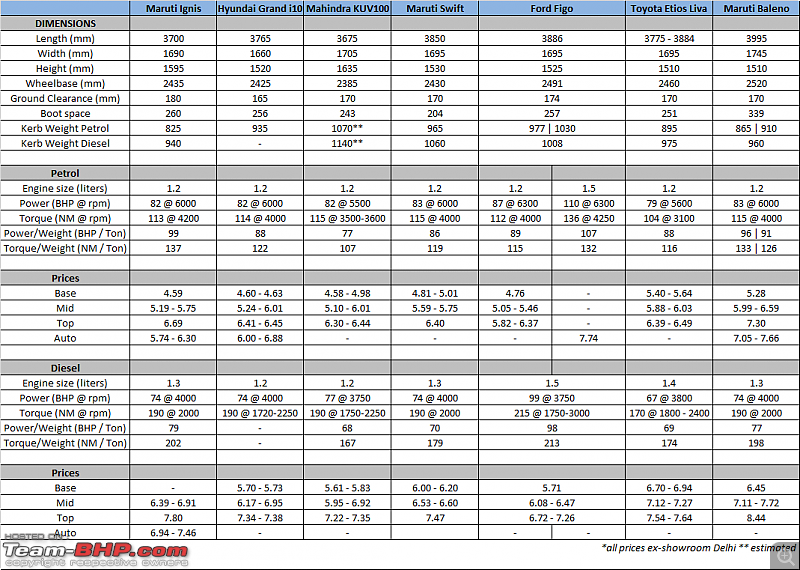 Until now Maruti was missing a crossover styled hatch in the B2 segment. The Ignis changes that. With a ground clearance of 180 mm, beefed up wheel arches, black plastic cladding on the sides and a retro squared off design, the Ignis mixes the tall boy design with a squat stance and a hint of mini crossover design. One thing is for sure, the Ignis looks different. When the car was first displayed in India at the 2016 Auto Expo, it immediately attracted crowds due to its styling. The styling will definitely have polarizing opinions. Some people will find it cute, others will find it weird. The upright front with the W-I-D-E grill that stretches across the entire width of the car encompassing both headlights is the standout design at the front. The headlights themselves are unique with a U shaped LED DRLs and LED headlights (a first for the segment) housed in projectors. Sadly, these are available only on the top end Alpha trim and the lower variants have to make do with regular halogen bulbs housed in boring reflectors and no LED DRL’s. On the side, the Ignis gets beefed up wheel arches, blacked out 15-inch alloy wheels and thick C-pillars with 3 slats resembling the Adidas logo, which denote the "Suzuki Progressive Triad". Moderator Ajmat pointed out that this design element was seen in the 1970’s on the Suzuki SC100 also known as the “Cervo” or the “Whizzkid”. The rear gets a retro-themed look with a steeply raked windshield and two-piece tail-lights. The rear is the most unappealing portion of the Ignis - something that it is common with the erstwhile Ritz. Many members here have remarked that the rear of the Ignis resembles the earstwhile Fiat Uno's. Overall, the car has an edgy and retro design - quite different from any other hatchback on sale. One cannot mistake it for anything else. The fit & finish are good with uniform panel gaps all over. However, the Ignis weighs just 825 - 960 kg depending upon the variant. This shows in the build of the car. The doors and bonnet are very light and there is a fair deal of flex when the sheet metal is pressed with your thumb. The tailgate is the only area which feels substantial enough. Overall build quality is however satisfactory - it’s not Euro solid, but it feels better than Maruti’s usual light + flimsy builds. The paint job on the other hand is good and up there with the Baleno's. The Ignis is available in 6 paint shades, but there are a host of customisation options available. The higher variants are available in dual-tone shades with either a black roof or a white roof for the blue shade and a black roof option for the red. Apart from the dual-tone colour options, buyers have an option to customize the exteriors and interiors. The amount of customisation available is like the Need For Speed games! Options include roof wraps, painted ORVMs, roof spoilers in carbon-fibre or coloured finish, foglamp & front grille garnish, side claddings in multiple colours, contours, carbon black door claddings, door visors, interior garnishes, ambient lighting, door way logo lamps, seat covers, leather steering wheel cover, carpet mats, boot mats, cushions, a 270W Kenwood multimedia system and a rear seat touchscreen infotainment system. Coming to safety, the Ignis gets two airbags, ABS + EBD, ISOFIX child seat mounts and seatbelt pretensioners with load limiters as standard. Though this is a welcome move, the Ignis in its European spec, which comes with front, side and curtain airbags, was awarded just 3 stars in crash tests. What was encouraging though, was that the passenger compartment was rated as stable. Maruti also claims that the car is compliant for pedestrian safety, side-impact, and offset crash regulations ahead of the set timeline. W-I-D-E grille, big headlamps with DRLs and bulging wheel arches give the Ignis good presence by hatchback standards. The grille is so wide that it extends outwards of the headlights and makes it seem that the headlights are inside the grille: 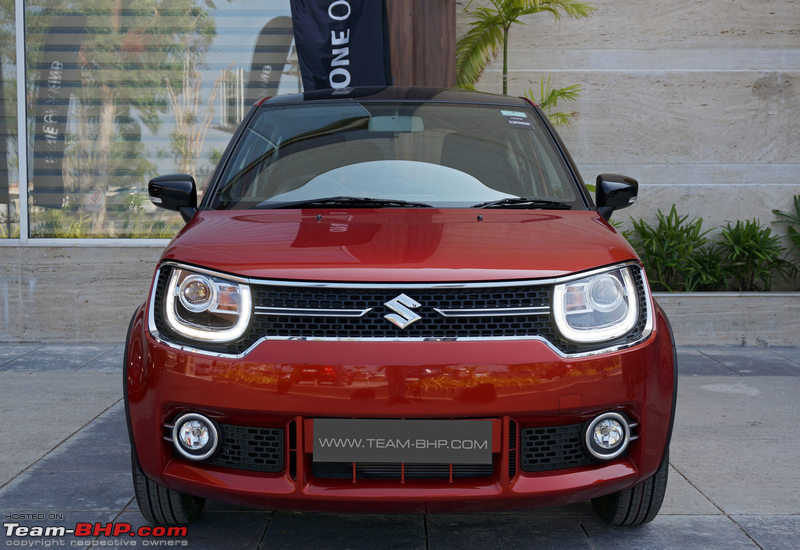 Rear end is ugly compared to the front. The flat windshield and hatch look like someone kicked the Ritz rear outwards. There are way too many cuts and creases on the boot lid and overall, the rear appears very old school: 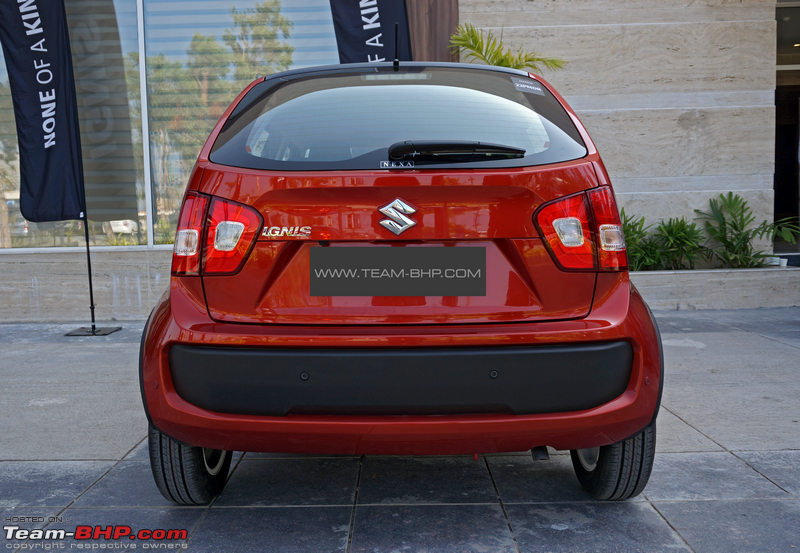 Viewed from the side, you'd never guess the car has a black roof. Notice how the wheels are placed at the extreme corners of the car. The wheelbase is long and overhangs are very short. Maruti calls the Ignis a "premium urban compact": 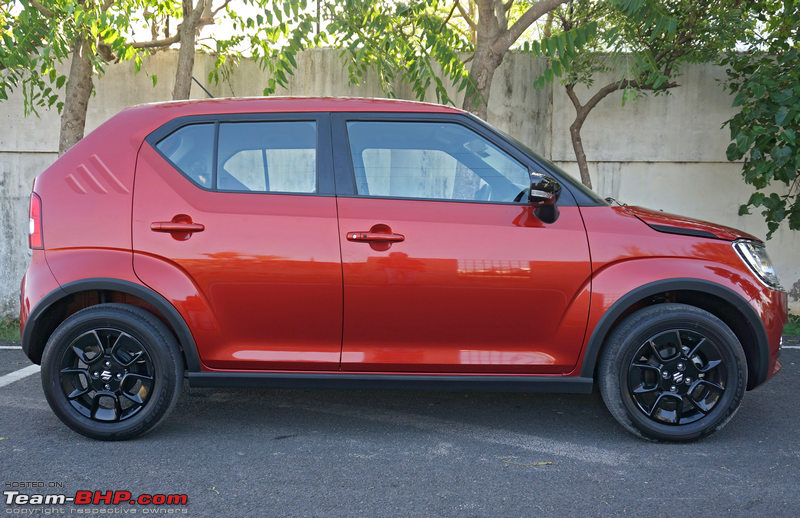 Unconventional design with a raised upright stance, a flat bonnet coupled with edges and creases all over make the Ignis stand out in a crowd and definitely turn heads wherever you go. Definitely looks better (or at least more acceptable) in person than the pictures: 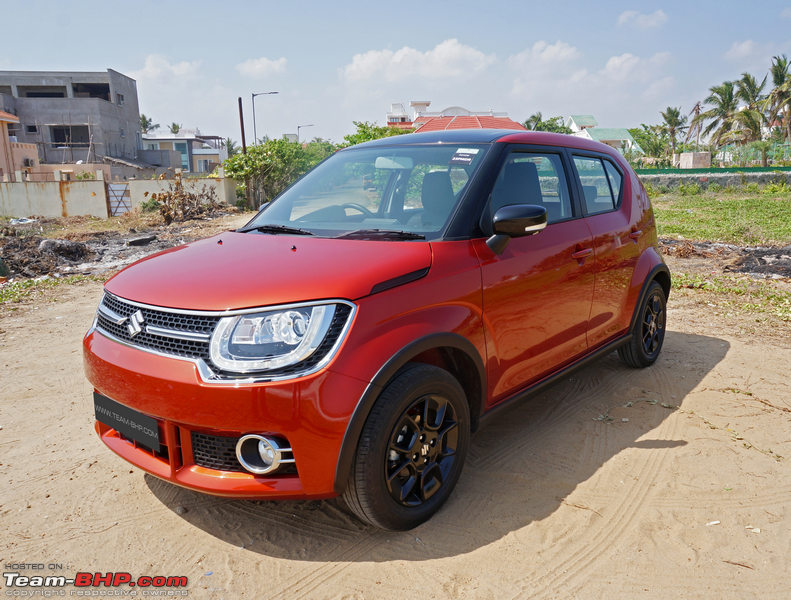 Overall build is light with the tailgate area feeling sturdier than other parts: 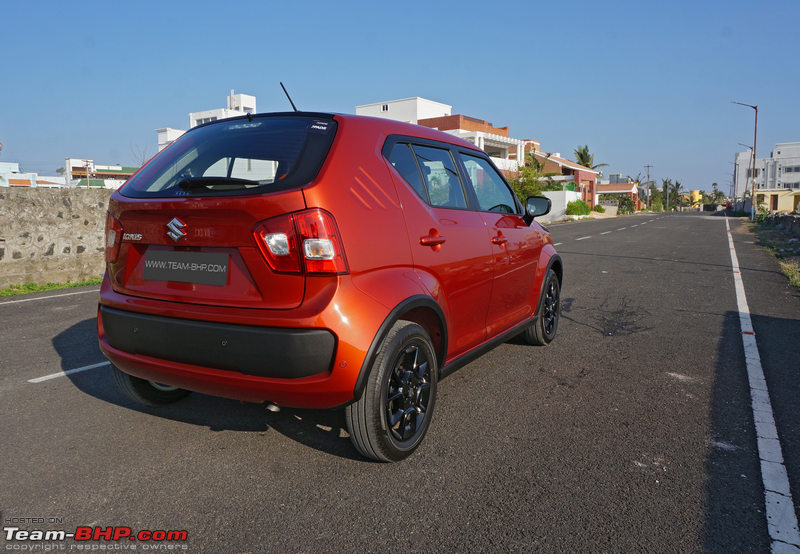 Alpha variant comes with LED projector headlamps and U shaped DRLs. This greatly enhances the front appeal versus the lower trim levels:  With all the lamps in action. Turn-indicators are located on the inner portion of the headlamp cluster. U-shaped DRLs are on all the time. Switching on the pilot lamps makes them dim a little: 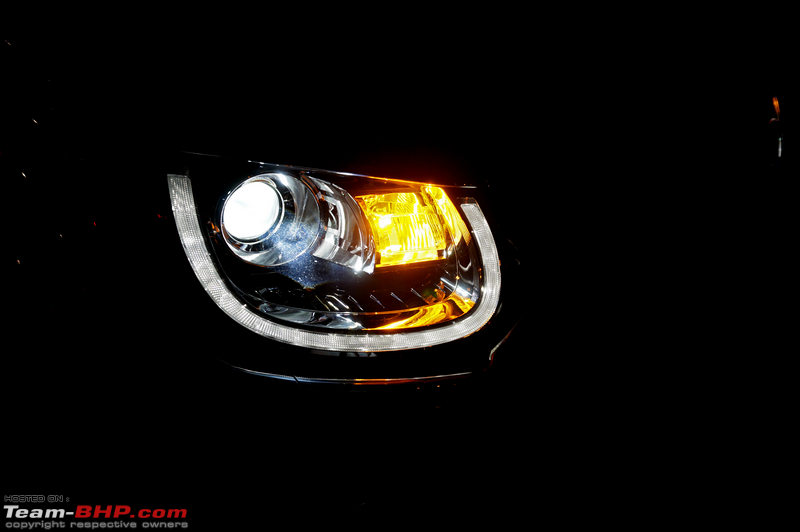 Zeta, Delta and Sigma variants get simple halogen headlamps and no DRLs: 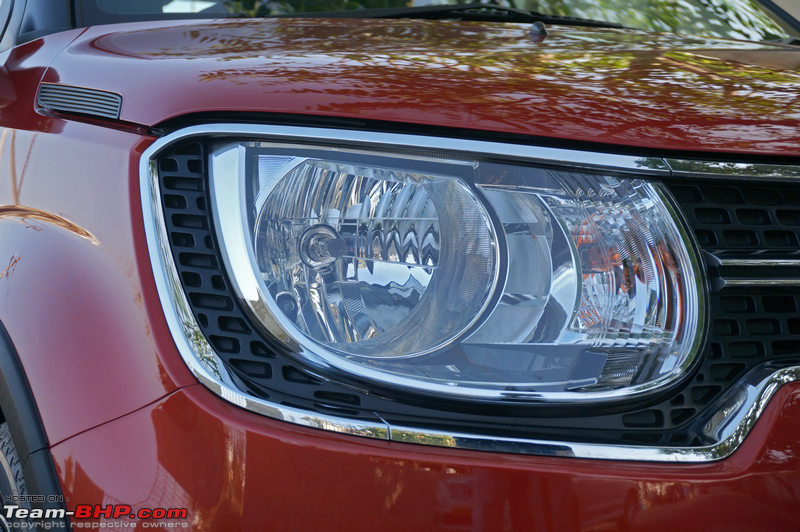 A look at the headlamp cluster with all the lamps in action: 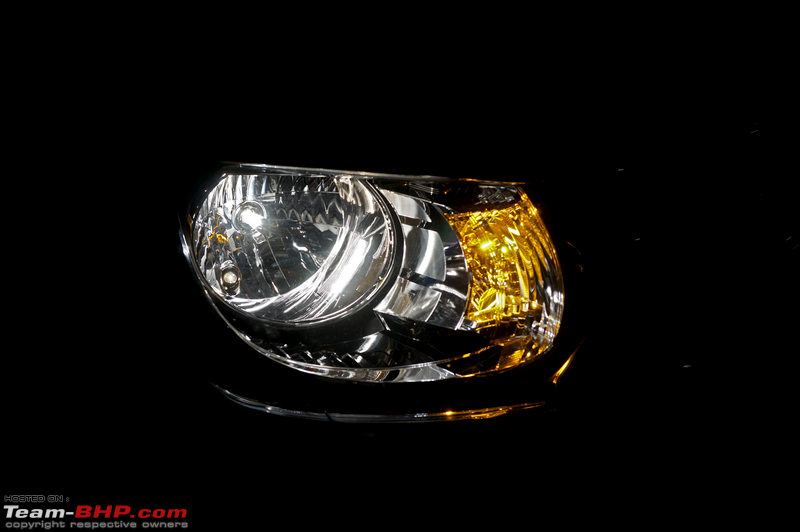 U-shaped DRLs are bright and prominent, even under bright sunlight. The front end design does have character and gives the Ignis a unique front look that is unmistakable: 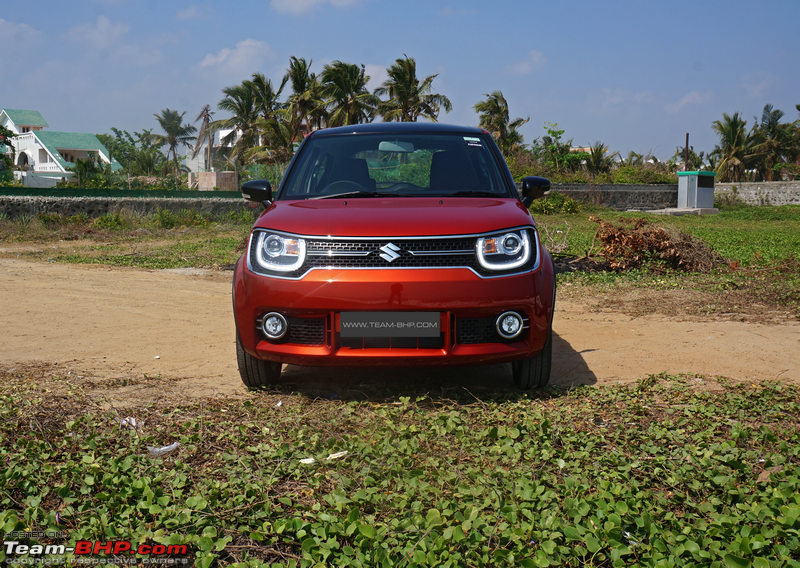 Bold, single frame grille has a honeycomb mesh design and a chrome outline. There are horizontal chrome slats in the middle as well and a large S badge. Even though there is a good deal of chrome used, it does not look overdone: 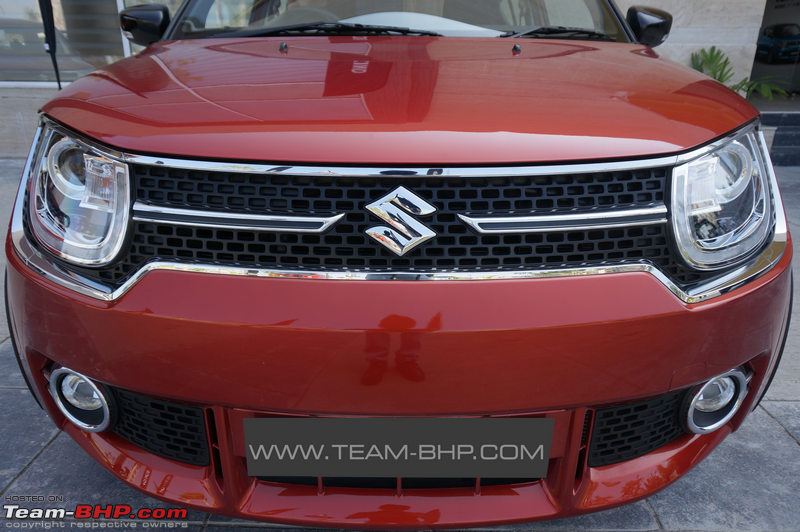 Front bumper houses a large air dam in the center. The mesh design pattern on the sides is carried over from the grille: 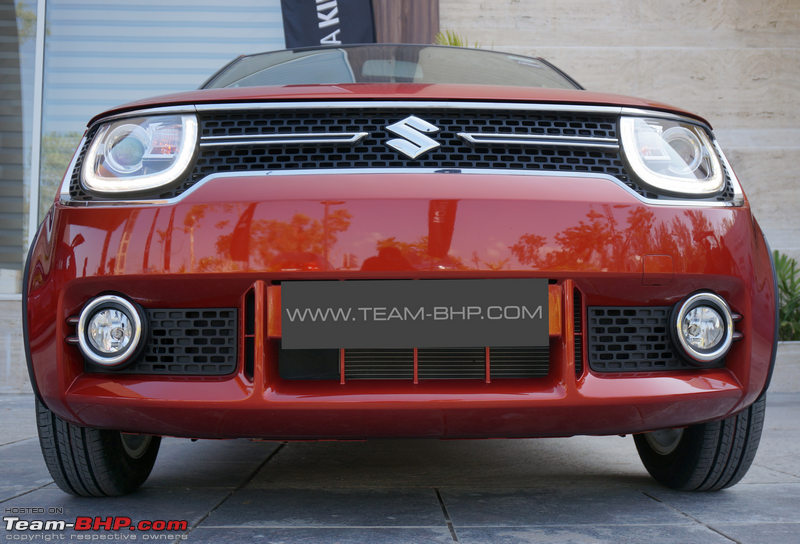 Air dam sports vertical slats with big gaps between them. Air-con condenser is visible behind the number plate and there is very little protection for it: 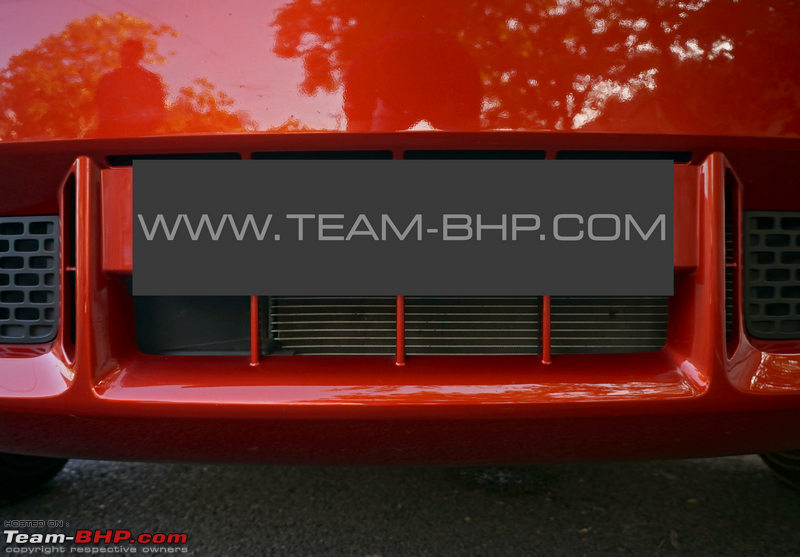 Round foglamps do a decent job of lighting up the edge of the road. They have black housings with chrome accents. Notice how some of the holes in the mesh grille are open while others are closed and some are partially open: 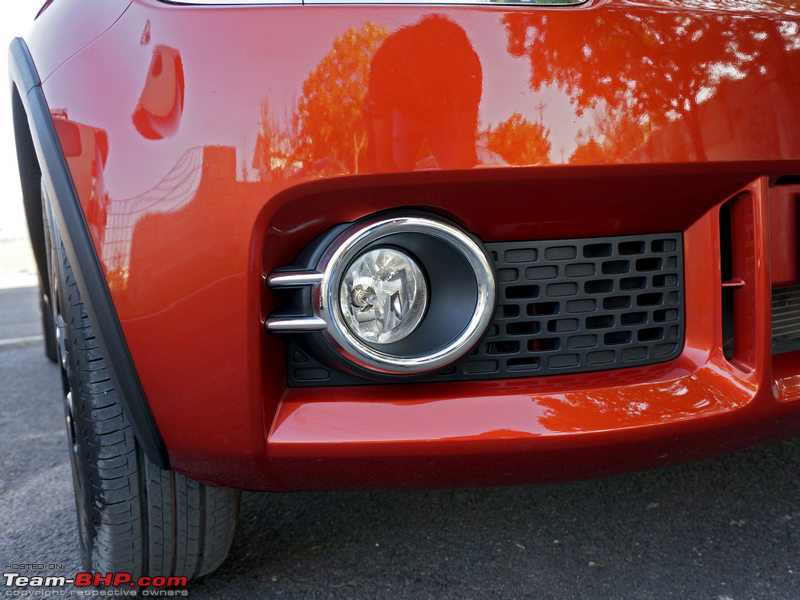 Shockingly, no underbody protection at all! Not even a plastic cover below the engine. This is unacceptable for Indian road conditions - Maruti should know better: 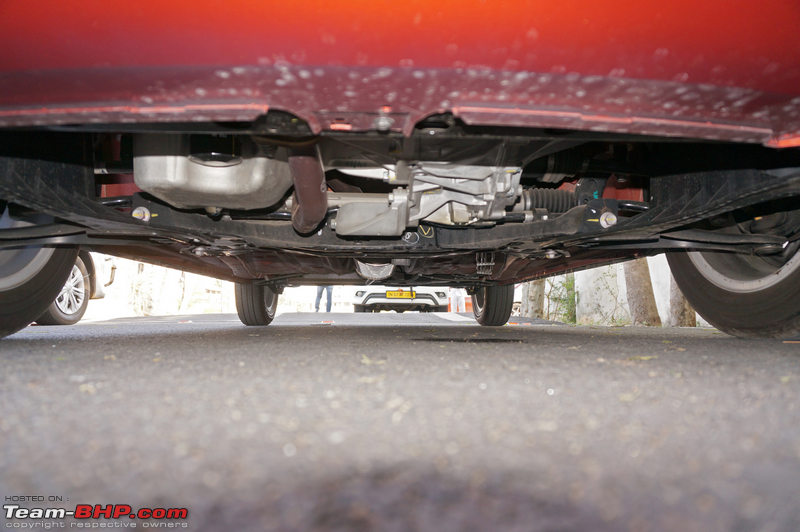 Bonnet has a clean design with no cuts or creases. The only eyesore are the 2 windshield washer nozzles that stick out: 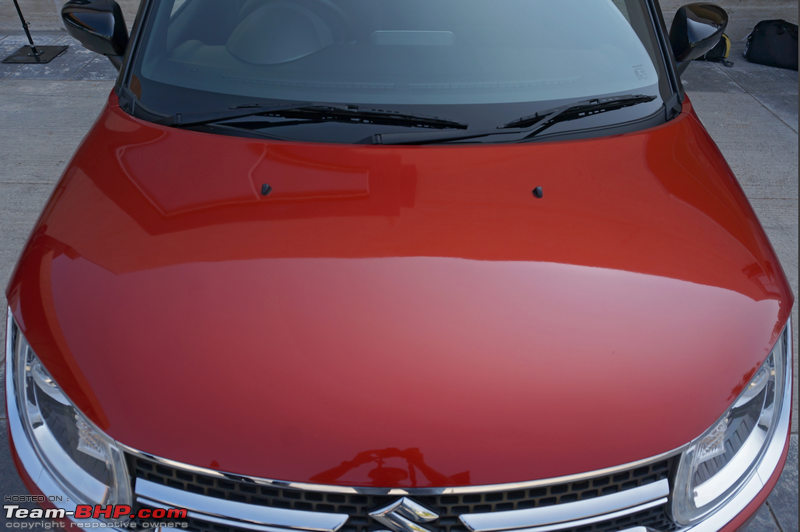 The wipers are well concealed over the blackened portion of the windshield: 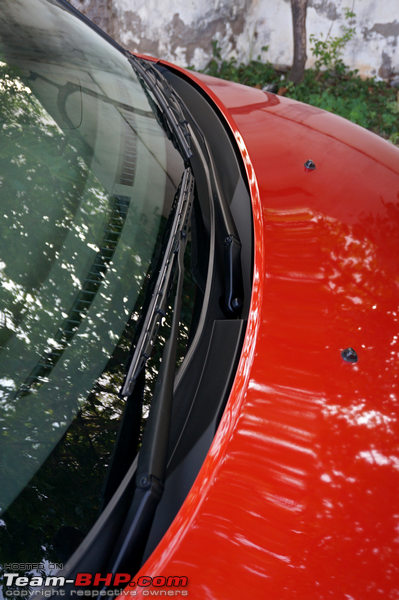 The two windshield washers shoot out water through two nozzles each: 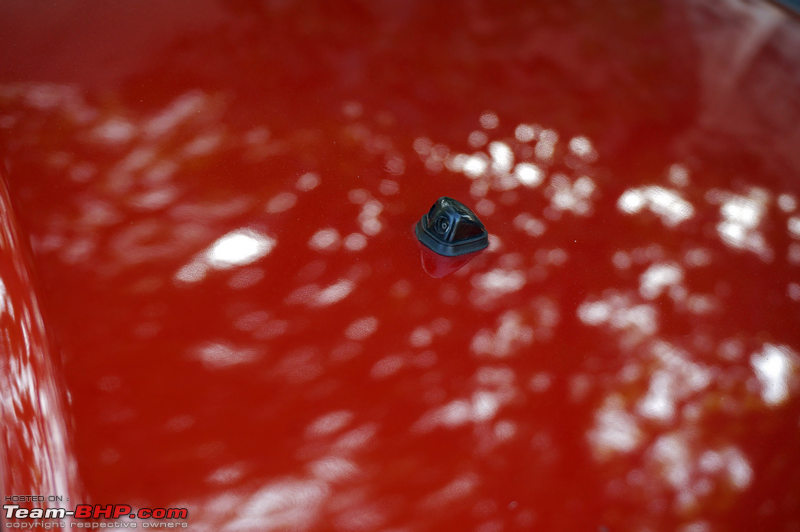 Shut lines are consistent and tight on most areas of the car… 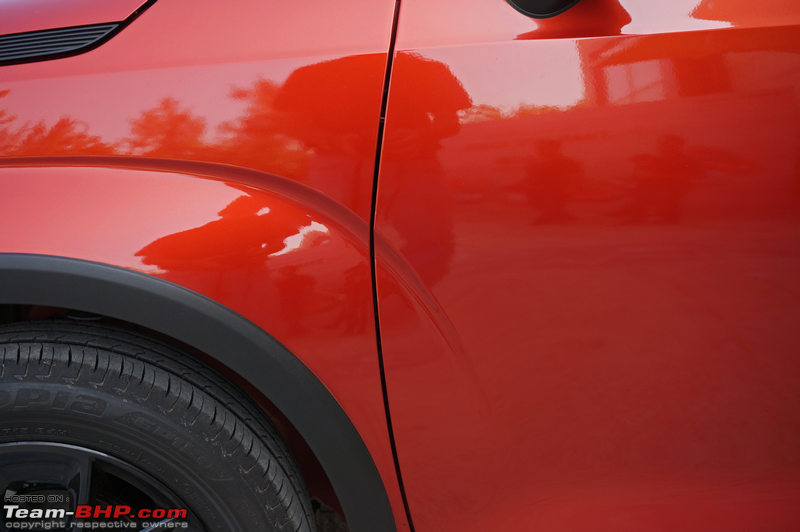 …getting wider only around the bonnet. Fake vent on the sides of the bonnet is actually a rubber insert: 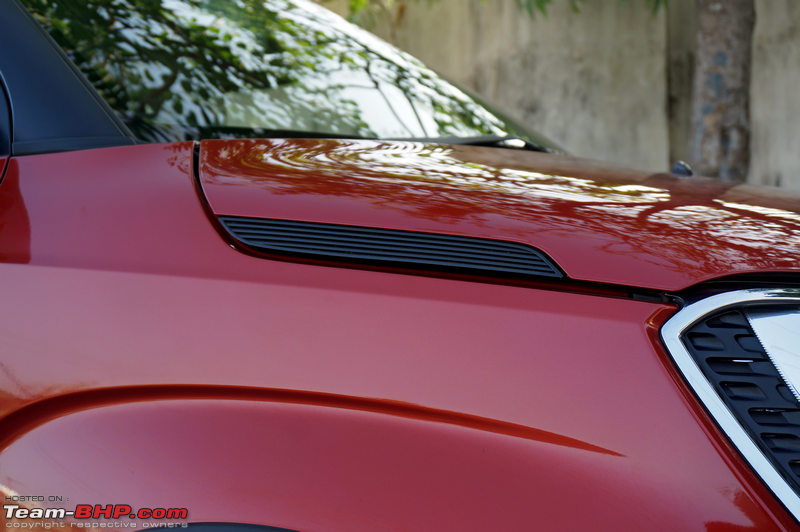 Diesel variants get DDiS badging on both front fenders. Petrol variants don’t get any badging: 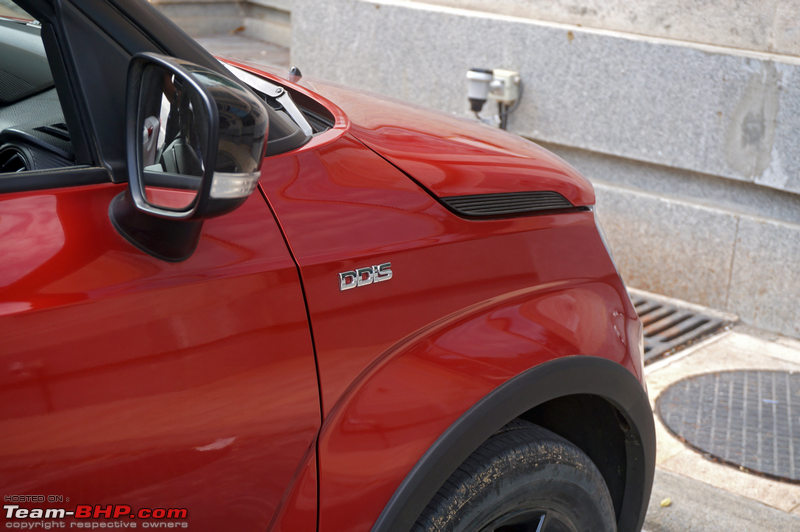 Glossy black ORVMs mounted on the door and get integrated turn-indicators: 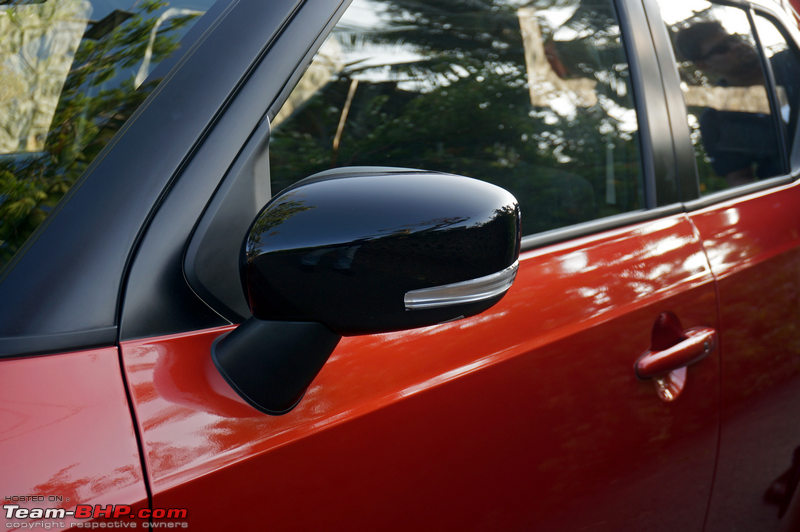 Body-coloured door handles do not feel firmly fitted and can be shaken around. Request sensors on both sides, but keyhole only on the driver's: 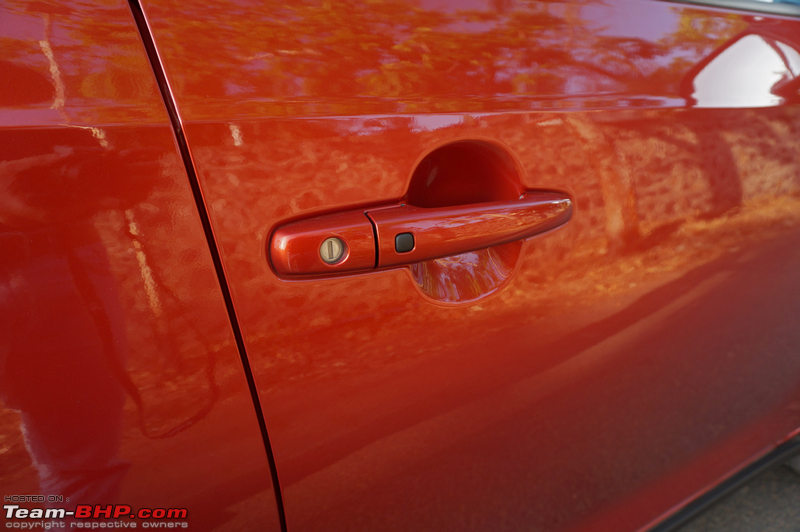 Funky trapezoidal 5-spoke all-black alloy wheels shod with 175/65 section Bridgestone rubber look sweet. It’s good to see 15” rims on a small hatchback as they fill the wheel wells nicely. Alloy wheels are standard only on the Alpha and Zeta trims. Lower trims get 15” steel wheels and even miss out on the wheel cladding. The Ignis would do better with wider rubber as the bulging wheel arches make the tyres look skinny especially from the rear: 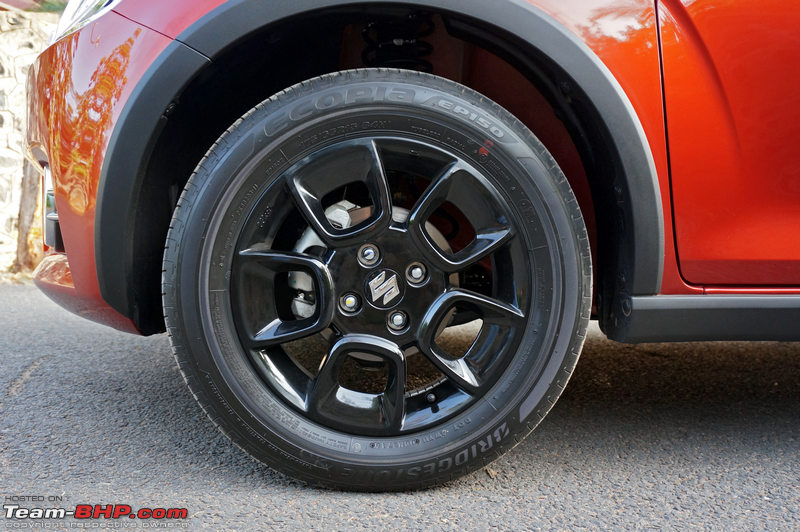 Wheel arches are very prominent and bulge out a long way. There's a thin black plastic cladding around the wheel arch which should protect the paint job against small nicks: 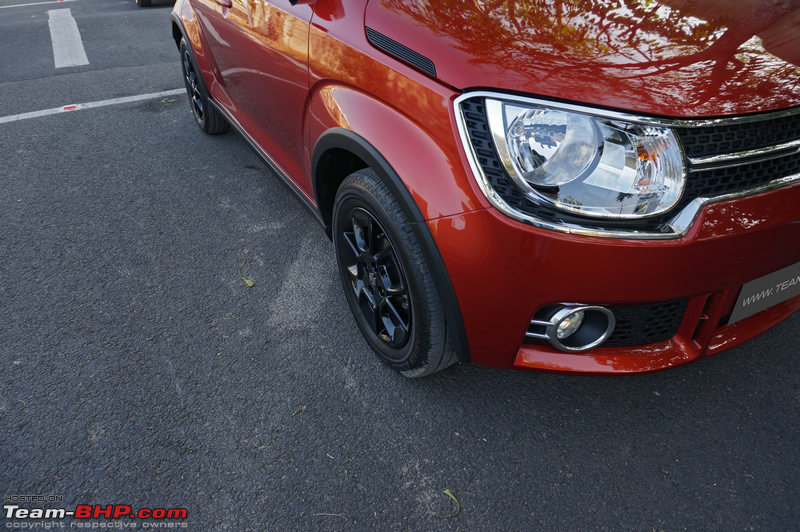 The wheel arch extends over to the base of the doors giving it an integrated and seamless appearance. There’s plastic side cladding on the running board but it doesn’t extend onto the doors: 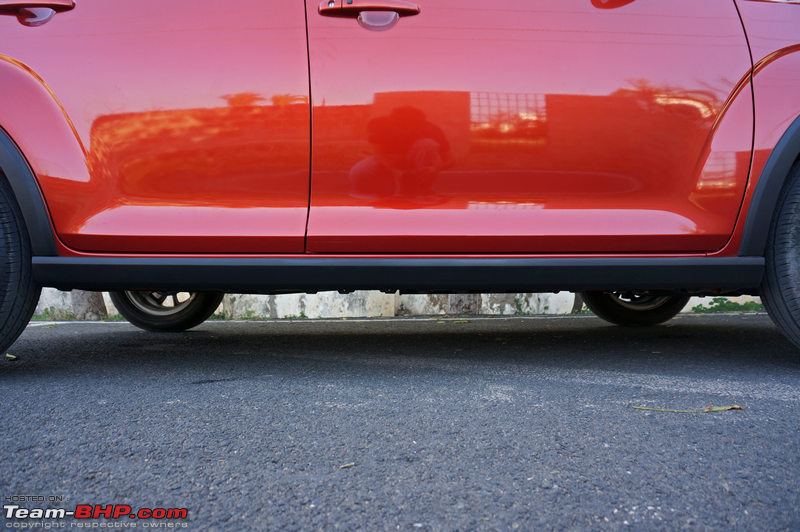 Side cladding will be a boon for inexperienced drivers as small scrapes won’t mean damage to the bodywork and paint: 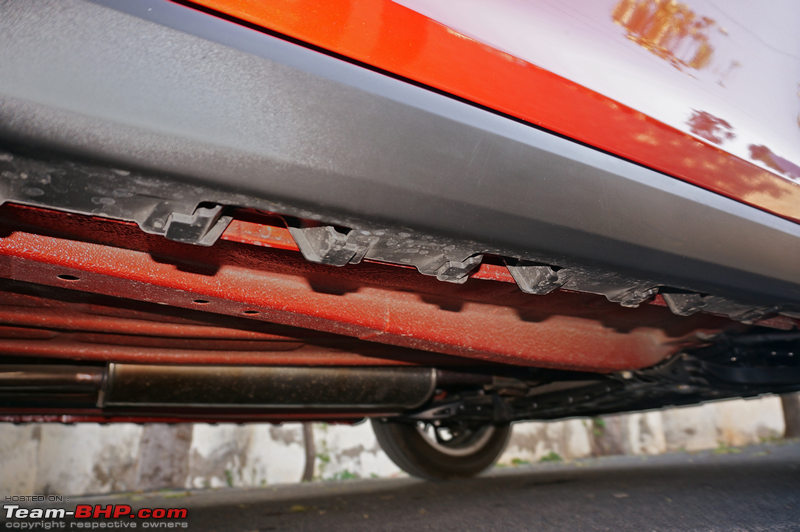 Blackened A-pillar - just like other cars from the Maruti stable:  Glass area is fairly large and there's enough light entering the cabin. B-pillar is blackened, while C-pillar is body-coloured and very thick, further accentuated by the window line which cuts back. Also note the roof which isn’t flat but rounded off: 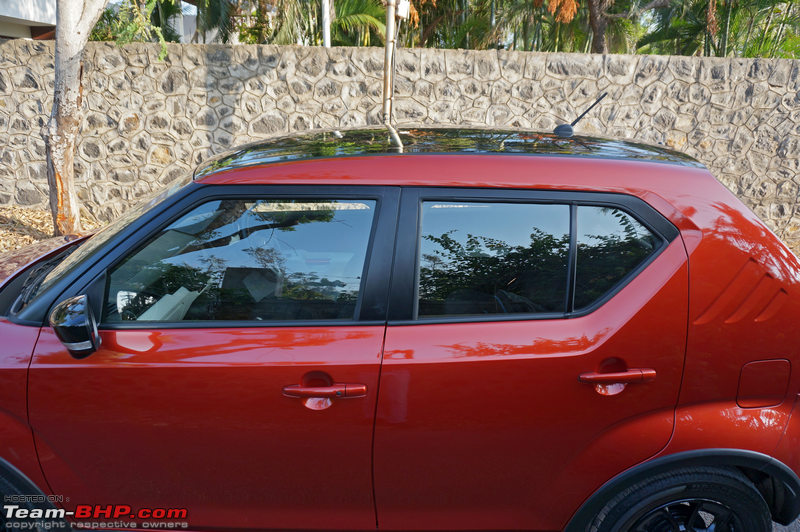 Rear quarter glasses are shaped such that they appear to point backwards. The bodyshell sports a crease that matches exactly with the one on the door (below the window) and forms an outline for the quarter glass: 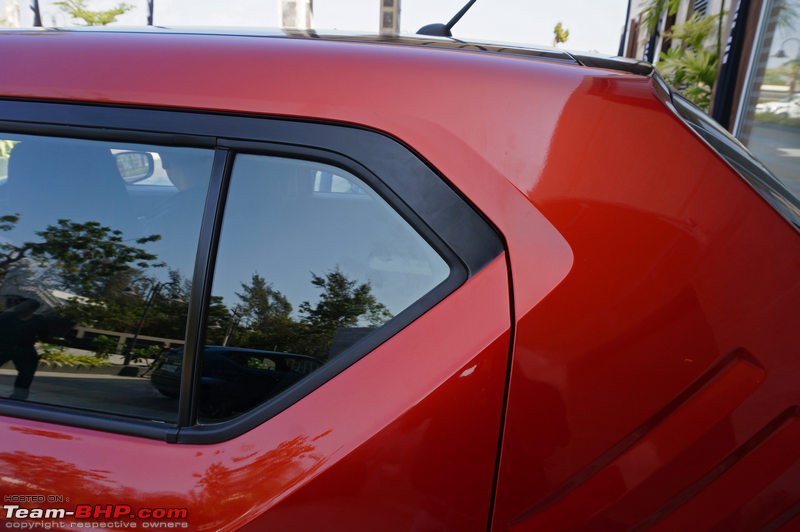 No, this is not an Adidas logo on the C-pillar. Maruti calls it the "Suzuki Progressive Triad" and it is not something new. It has been used by the company in the past on the SC100 from 1979: 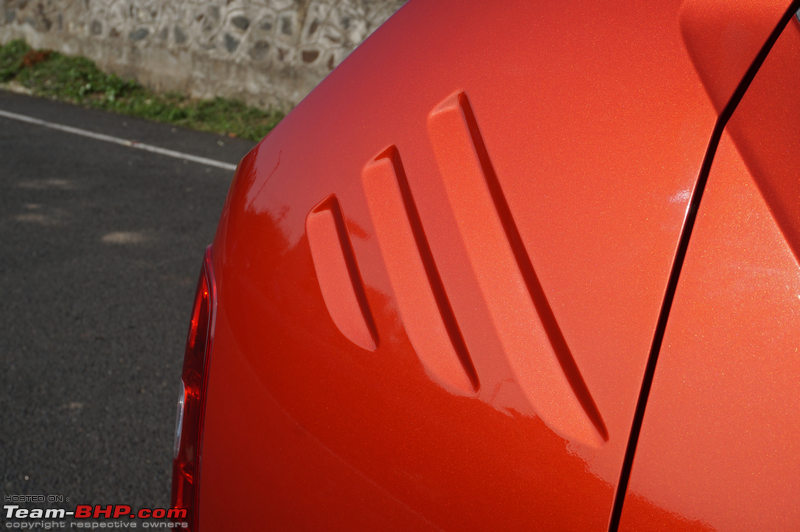 Alpha and Zeta variants are available in dual-tone colour schemes. The Uptown Red paint job can be ordered with a roof that is finished in a glossy Midnight Black shade: 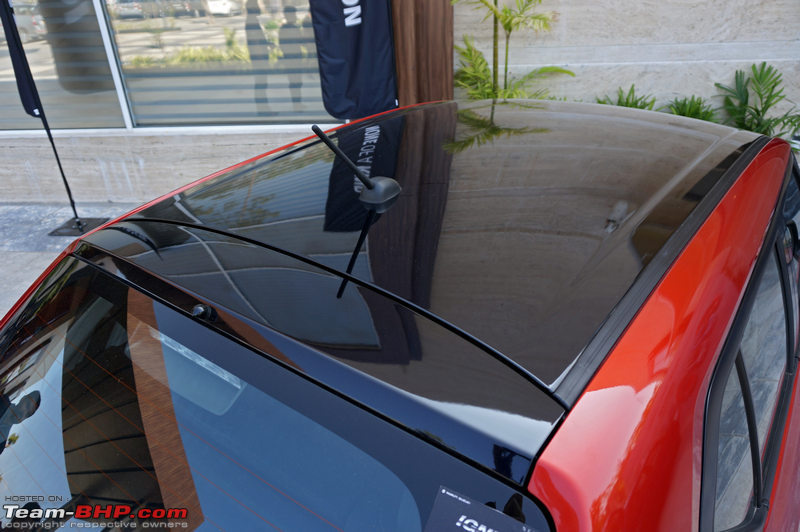 Short, stubby roof antenna is shared with the Baleno and sits toward the rear: 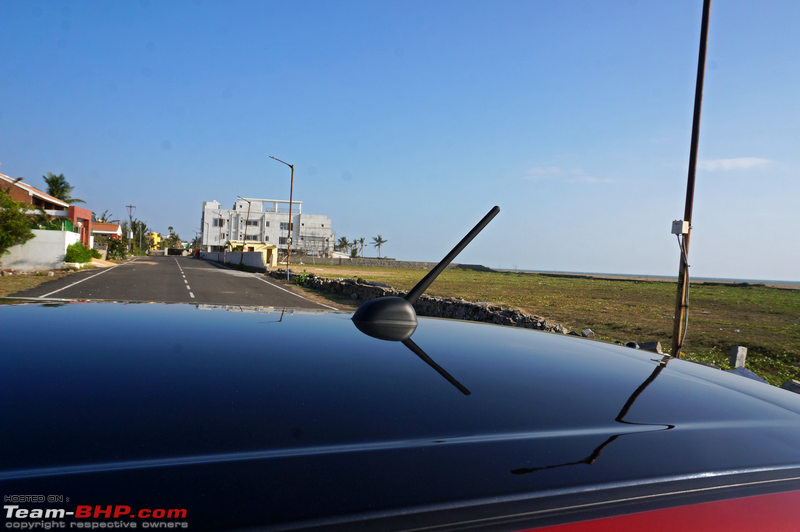 Just below the rear windscreen, the tail gate sticks out a little more than the rear bumper. One needs to be careful when backing up as the bumper isn’t going to help much and the brunt will be borne by the tailgate: 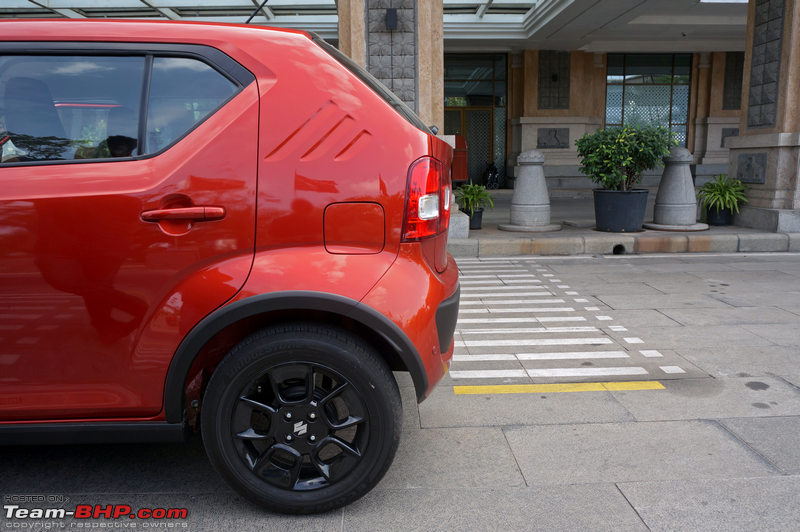 Bodyline tapers inwards as you go towards the rear pronouncing the bulge of the wheel arches more than the ones at the front: 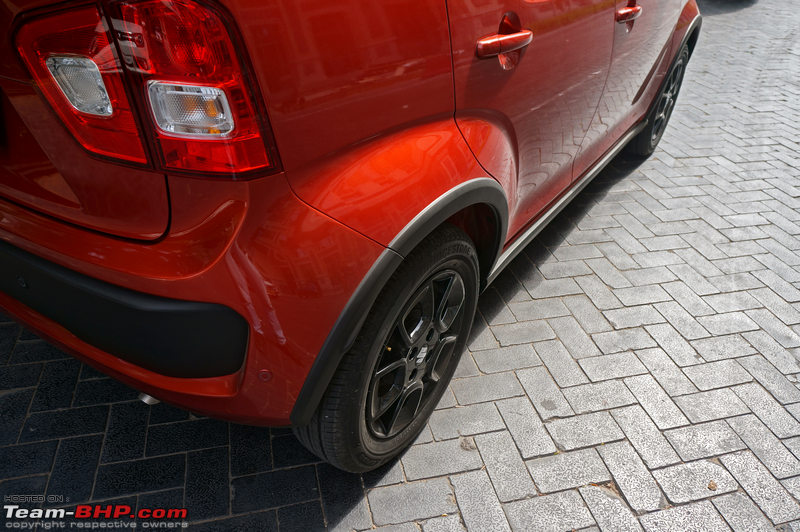 Like all the other cars in the segment, rear wheels get drum brakes: 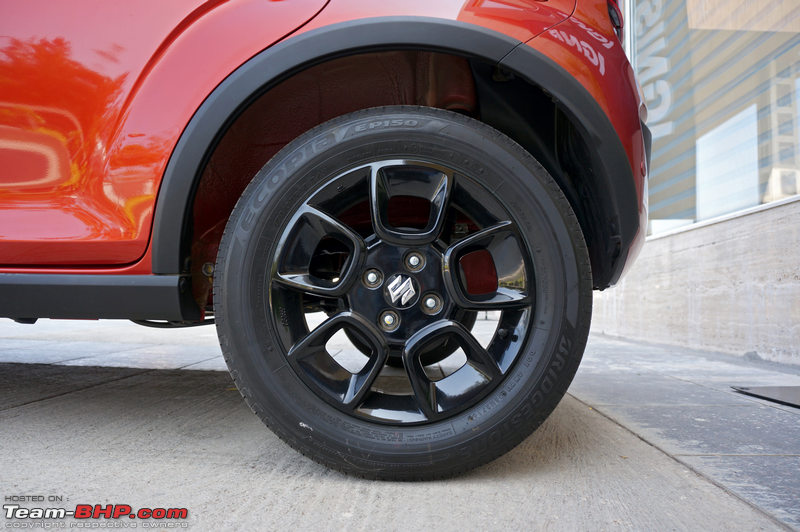 Wraparound halogen tail lamps are split units with portions located on the tailgate as well as the bodyshell. They feature the regular parking & brake lamps, turn indicators and reversing lamps. The red area on the tailgate section of the lamp is only a reflector. No rear fog lamps: 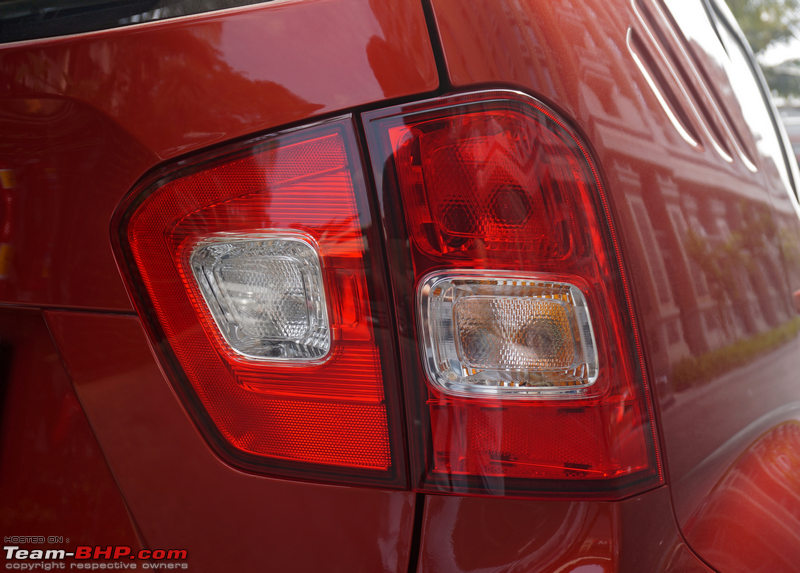 With all the lights in action. The brake lights are kind of small in an otherwise wide shaped rear:  No roof-mounted rear spoiler means that the washer sticks out just above the windshield. What's cool is that it is finished in glossy black, which makes it look like a part of the roof: 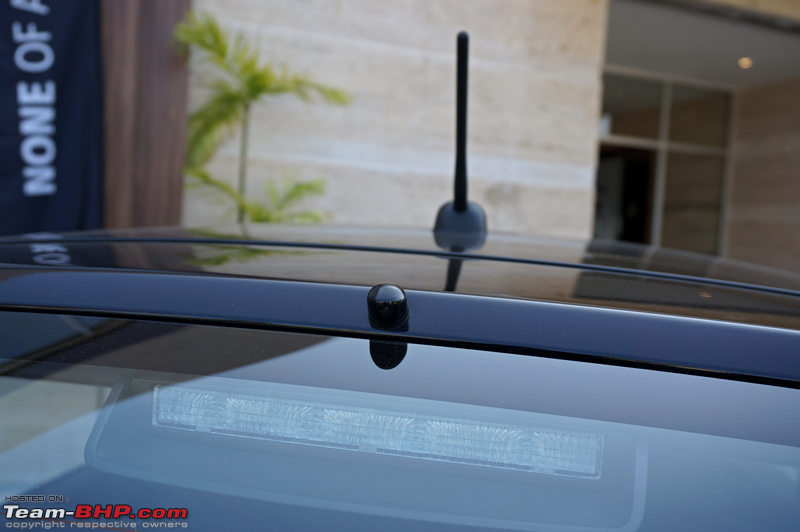 Rear wiper is provided on the Alpha and Zeta variants. Interestingly, on the S-Cross and Baleno, the wiper's resting position is on the left, while on the Ignis, it's on the right. Notice how the portion of the tailgate below the windscreen forms a lip on the tailgate: 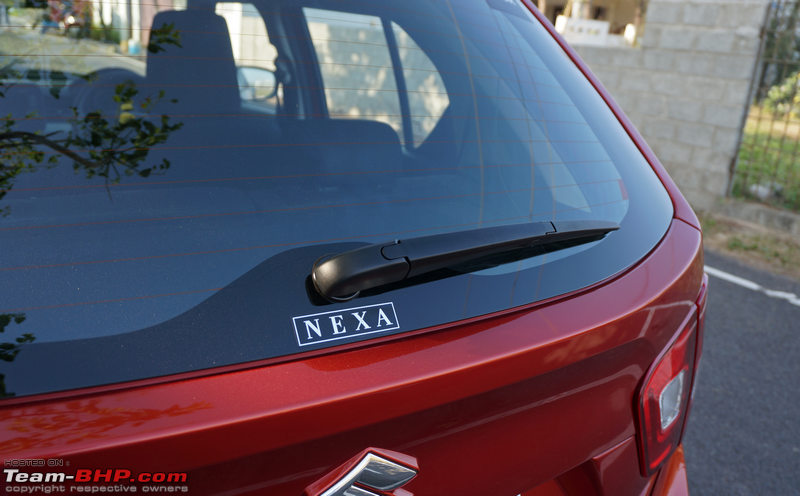 Ignis badging on the tailgate. The word "Maruti" is not mentioned anywhere on the car. Even the variant is not displayed: 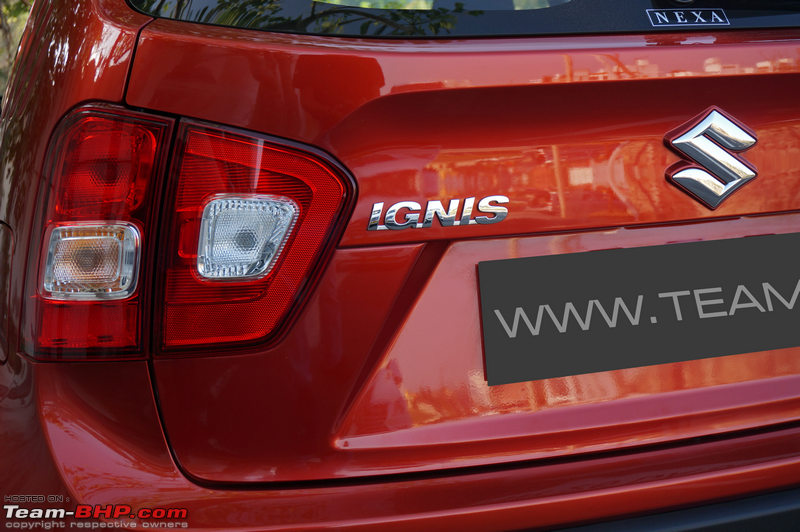 Small reversing camera is well integrated and sits at the top of the number plate housing on the left side: 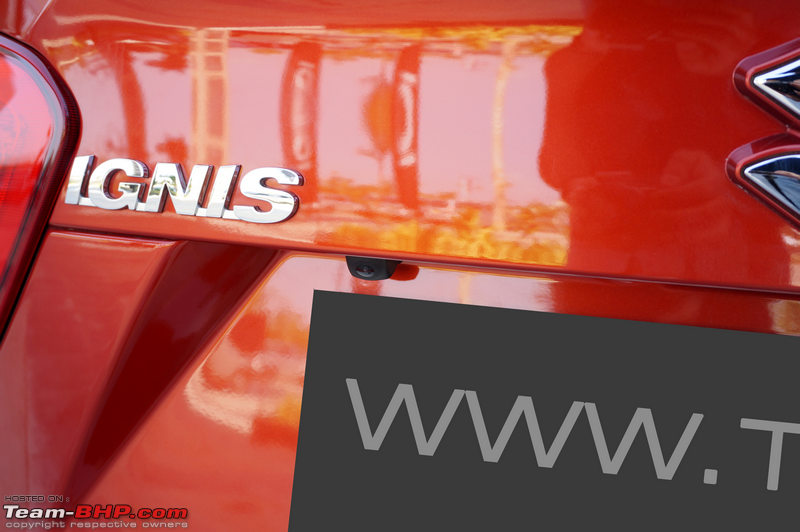 Boot release handle on the left with the small 'lock / unlock' button on the right. With the smartkey in your pocket, simply press the unlock button followed by the boot release to open the tailgate: 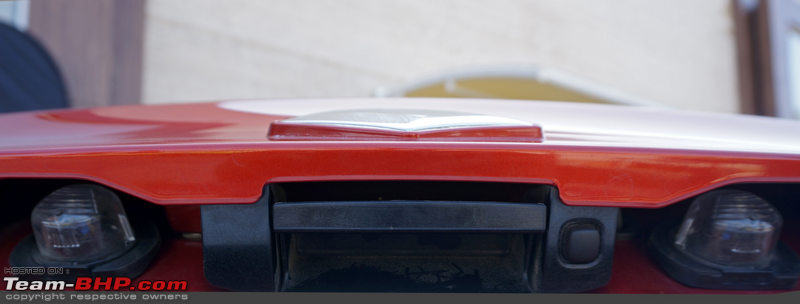 Rear bumper gets a massive black insert - will be helpful in preventing scratches. 4 parking sensors and a cut-out for the tail pipe are provided. International variants get fog lamps on the sides – sadly missing on the Indian car: 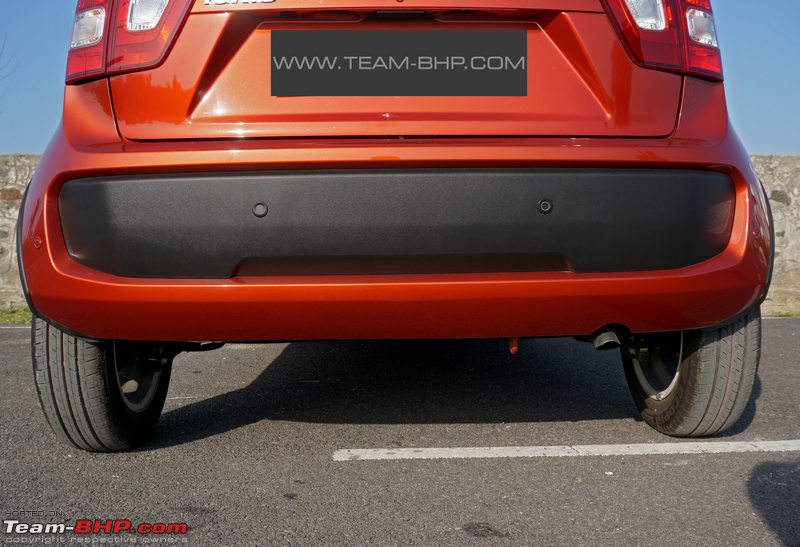 180 mm of ground clearance is enough to help you clear most obstacles on the road. Rear suspension is a torsion beam setup: 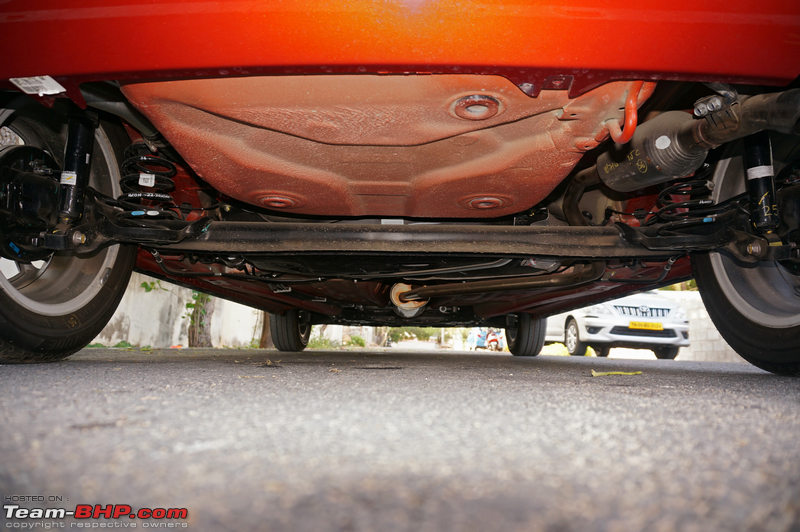 Tow hook and tail pipe are located towards the right side: 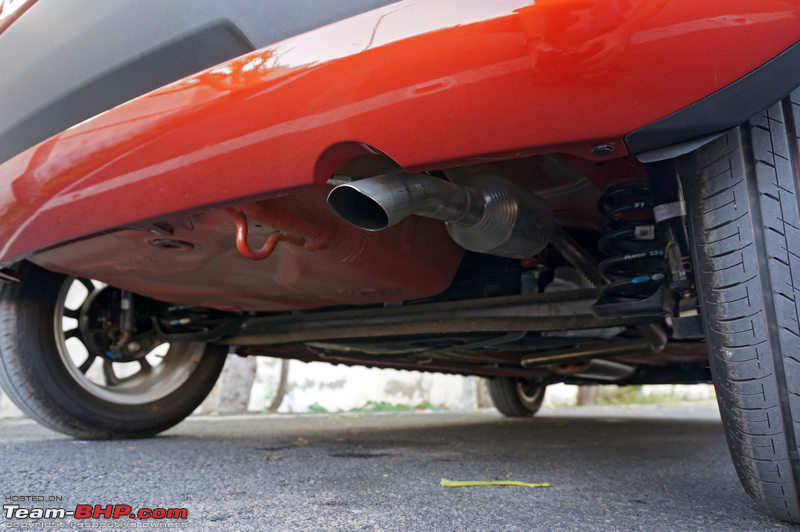 Exhaust pipe snakes it’s way around the fuel tank: 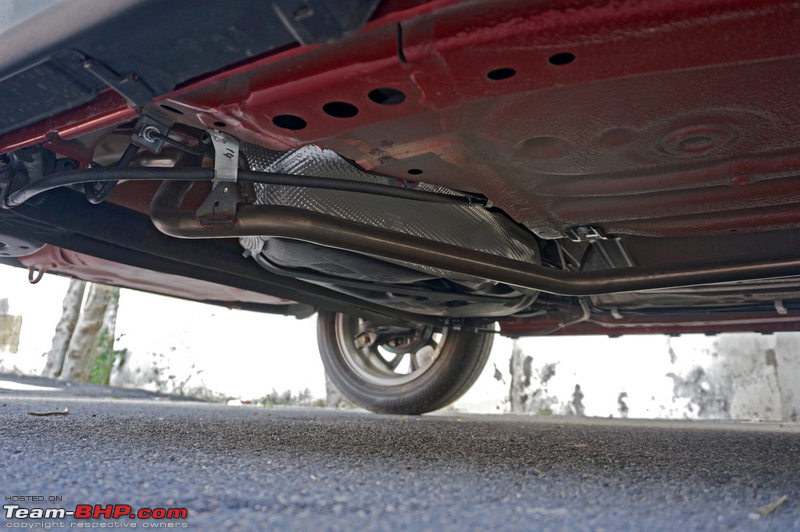 Like most hatchbacks on sale, Ignis uses a McPherson strut suspension setup at the front: 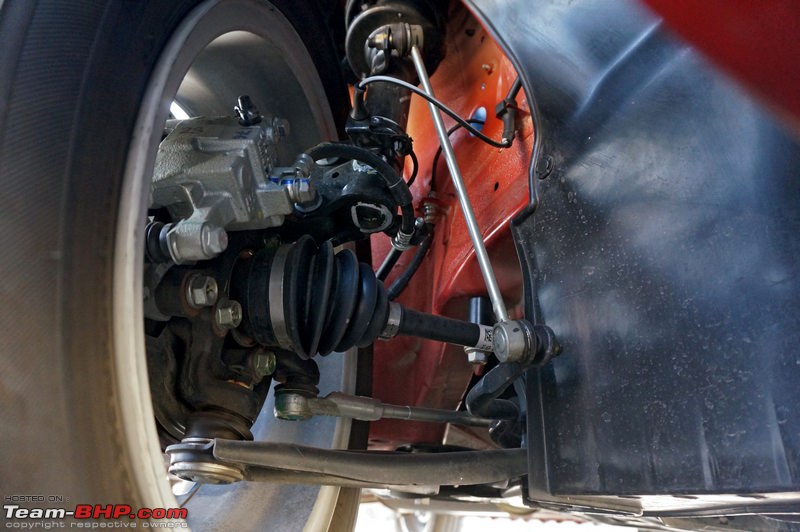 Retro-styled Ignis looks boxy and upright compared to other hatchbacks in the segment: 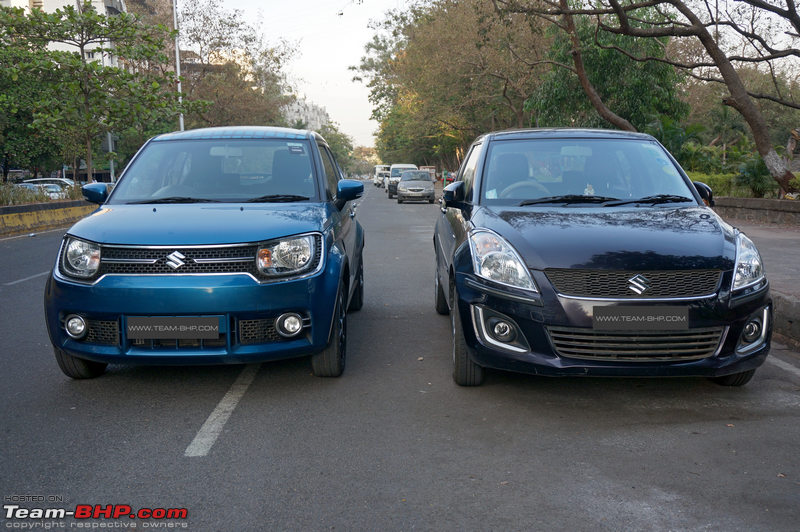 Just look at how pronounced the Ignis' wheel arches are! Plastic cladding on the wheel arches and sides give it a pseudo-SUV appearance and make it look more imposing than it actually is. The Swift is the longer car here by 150 mm, however the Ignis has a longer wheelbase (5 mm): 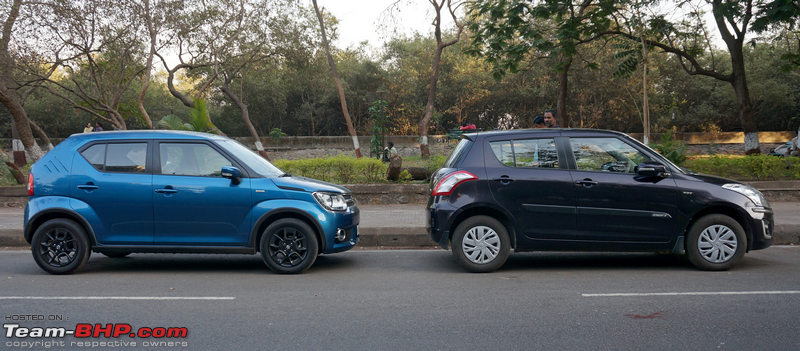 Ignis rear with the large flat rear lamps looks ugly when compared to the swooping derriere of the Swift: 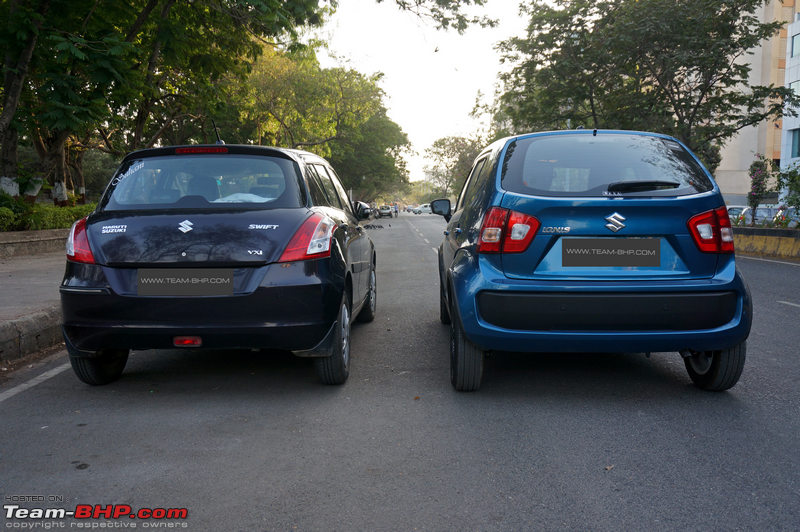 With its main rival. Those who prefer clean lines, will definitely go for the Grand i10. Just notice the number of cuts and creases on the Ignis' side. The Ignis is actually 65 mm shorter in length than the Grand i10, but has a wheelbase longer by 10 mm: 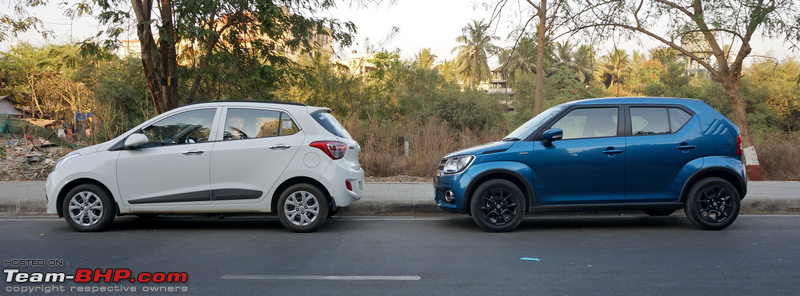 Though boxy and high, Ignis is not quite as tall as a traditional tall-boy: 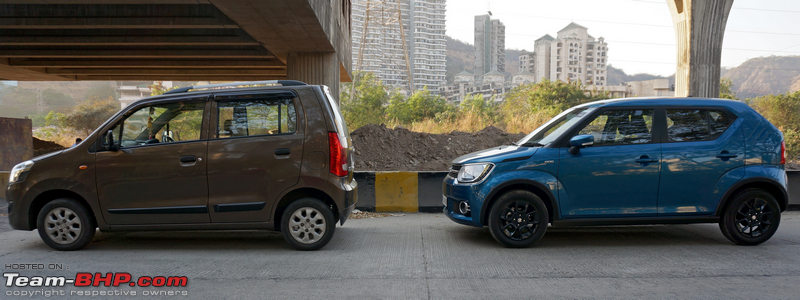 Last edited by Vid6639 : 18th April 2017 at 17:51. |
| |  (53)
Thanks (53)
Thanks
|
| The following 53 BHPians Thank Aditya for this useful post: | ach1lles, aeroamit, akshay81, Avikbrio, CarguyNish, carrazy, Chethan B G, Crazy_cars_guy, deetjohn, Gannu_1, GTO, harry10, hemanth.anand, hiren.mistry, InControl, Jaggu, Karthik Chandra, Leoshashi, mallumowgli, manij, noopster, Patriot_Vishwas, PGNarain, Ponbaarathi, predatorwheelz, procrj, Rajeevraj, rav11stars, RavenAvi, Reinhard, rohitoasis, romeomidhun, rshanker, samabhi, samaspire, sdp1975, shancz, Sheel, Simhi, SmartCat, subhro1988, suhaas307, sunny29584, timuseravan, uday.ere, v12, vaasu, vb-saan, vibbs, vishnu.csk, vishy76, Voodooblaster, WAM-4 |
| | #4 |
| Team-BHP Support  | Interior - Front  The front doors open and shut in a triple-stage action. Immediately you realise how light they are - a reminder that the Ignis weighs only between 825 and 960 kilos, depending on the variant. There is certainly no "European thud" when you shut the doors. The doors open wide enough and ingress egress is easier than in the Swift (although incomparable to the Wagon R). The floor of the car is not too high and the running board is not wide either. The roof is high and the seat is at a comfortable height. Ergonomically, the cabin is well laid out and all controls are easy to find and reach. The Ignis is well-packaged in terms of cabin space. There’s good legroom & headroom all round. However, the cabin is narrow and best for 4 onboard. The 5th passenger will be a tight fit. Unlike the neutral designs seen in most Maruti cars, the interiors of the Ignis are unconventional and I dare say, polarising. The dashboard has a floating infotainment system, which appears to be stuck on as an afterthought and the plastics around the corner air-conditioner vents and on the cowl of the instrument cluster sport a fake carbon-fibre finish around them. Maruti has gone with a black & white colour theme, with silver, chrome, piano-black and body-coloured inserts at various places. While the white bits brighten up the interiors and look funky they are on the lower part of the dash and door pads. Expect these to turn to grey within a few days and a royal pain to keep clean. Expectedly for this segment, the plastics on the dashboard are all hard and with no soft-touch materials used anywhere. While the finish is good with no sharp edges at places that occupants are likely to touch, the overall quality of the plastics is about average and not at par with the likes of the Grand i10. Surprising it feels a little better than its larger sibling, the Baleno, which could also be due to the larger expanse of plastics in the Baleno vs the Ignis. The Ignis has some budget grade plastics, but they are in places that are not frequently accessed by occupants. On the other hand, while some of the switchgear is taken from other Maruti cars, all the buttons and switches feel good to use and well-built. In fact, Suhaas was of the opinion that their quality was better that the switches used in the Honda Jazz, which he reviewed in 2015. Interiors have a black and white theme with body-coloured inserts on the center console and door grab handles. This treatment helps liven up things. The design is unconventional, but functional at the same time and ergonomics are well sorted:  The interiors do not feature any soft touch materials. As the Ignis is being sold through Maruti's Nexa premium dealership network, it could have done with materials offering a better feel. Frontal visibility is pretty good thanks to the higher seating and the dash height being low. Visibility can be a deciding factor if anyone is choosing between the Baleno or Ignis especially for those who don’t need the additional space offered by the Baleno:  Driving position is higher compared to conventional hatchbacks. Large windshield offers a good view of the road ahead:  Windshield washers are visible from the driver's seat. The bonnet is visible but not till the end as it tapers downwards:  Plastic cowl on top of the instrument cluster gets a fake carbon-fibre finish along its border. Looks funky:  Finally the 3-spoke steering wheel has a different design compared to other Maruti cars. It still doesn’t get thumb contours, but is beefy enough to provide a good grip. The hornpad is now smaller than the older design and the bottom is now 2 spokes in silver in a V shape. While the hornpad is easy to press, it’s now a farther reach for those with shorter fingers: 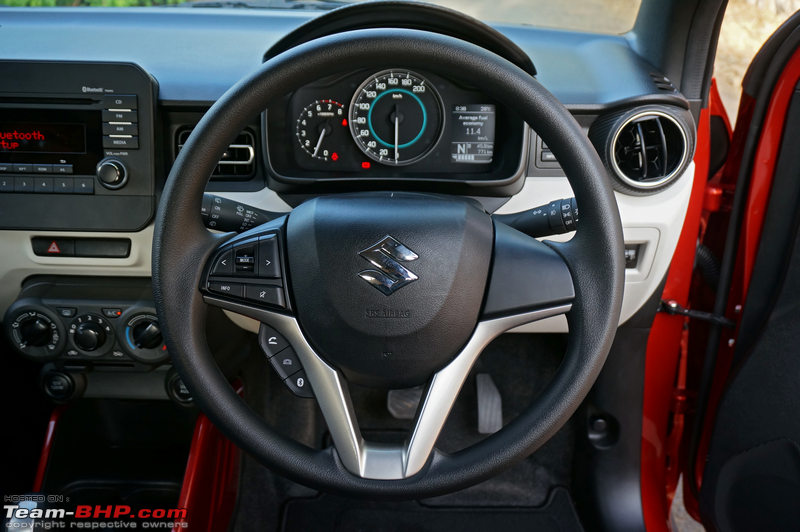 Buttons for controlling the audio system are all new as well. The volume and source can now be changed via a toggle switch. info button is used to toggle through the functions of the MID. Mute button will also pause the song that is being played: 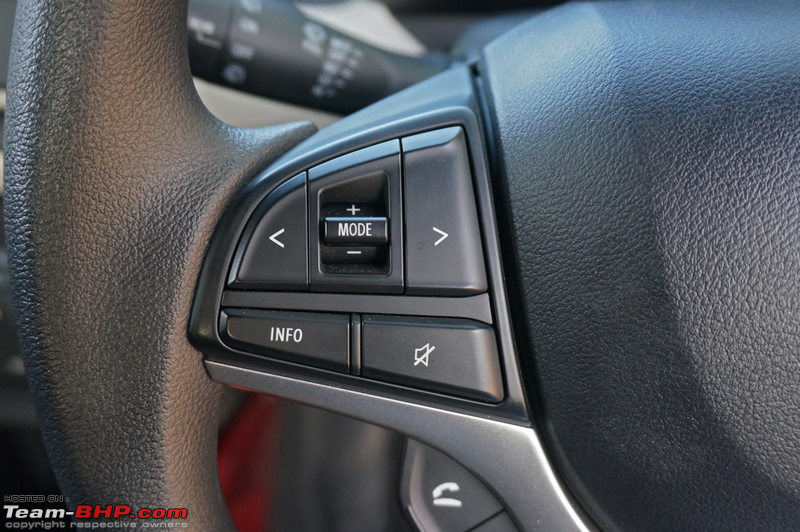 Telephony controls have a unique location behind the wheel. Unlike earlier Maruti cars, you now have to press these buttons instead of pulling them towards you. Alpha variant gets a button for voice commands, while lower variants get a button to operate the Bluetooth:  Steering can be adjusted for height only, not for reach even in the top spec. A big miss as the Baleno has it:  Instrument cluster consists of a large speedometer in the middle, tachometer on the left and a LCD display on the right. White letters and numbers look classy and are easy to read. The 6 o’clock position for the needles looks sporty. No temperature gauge provided. Petrol version redlines at 6,400 rpm:  Alpha variant gets a funky decorative illumination on the top of the dials. Diesel version redlines at 5,000 rpm:  Buttons to toggle through the various functions of the MID and for adjusting the illumination are located to the right of the instrument cluster. These are much easier to operate compared to the fiddly stalks in other Maruti cars. Short press the Trip button to toggle between the two trip meters and long press it to reset them. With the brightness of the MID, the illuminations for the infotainment system, air-con and instrument cluster brighten or dim. There’s an info button here as well as the one on the steering. Weird!  MID readouts before starting the engine. While the manual version requests you to press the clutch and brake to start the engine, just pressing the clutch is enough to start. The AMT requires you to press the brake and shift to N. If you press the start button without depressing the clutch (brake in the case of the AMT), the car enters 'accessory' mode. In accessory mode, you can operate the stereo. Pressing the engine start button twice without depressing the clutch (brake in the case of the AMT), the car goes to 'ignition mode'. If you depress the necessary pedal, it prompts you to fire up the engine by hitting the engine start button:  MID is black and white and relatively simple. Provides adequate information, including bars for the fuel gauge, with digital read-outs for the odometer, time, outside temperature, two trip meters, average + instant fuel economy and a range / DTE counter. Other information relayed consists of average speed and driving time. One can even set the MID to show nothing in the large portion of the screen:  While the brightness level of the instrument cluster can be adjusted by using the dedicated button switch, the other settings can be accessed by long pressing the info button. Settings that can be altered include the units for distance, fuel economy as well as the language of the menus. Surprisingly, even though the car is made in India, there's no Hindi or regional language on offer. You can also change when the value of the average fuel consumption is reset and the unit of measure of the outside temperature:  Additionally, you can change door lock / unlock settings. Choosing "all doors" in the door unlock section will allow you to unlock all doors (including boot) of the car by a single press of the unlock button on the keyfob. If "driver door" is chosen, pressing the unlock button on the keyfob once will unlock only the driver's door. You have to press the unlock button on the keyfob a second time to unlock the other doors like some Euro cars. You can choose to lock all doors manually or automatically, based on speed (15 km/h). Similarly, you can choose to unlock all doors manually or synchronise it with the switching off of the engine. The lane change feature of the turn-indicators can be deactivated as well:  Lastly, you can play around with the anti-theft sensor settings. Activate (Mode D) or deactivate (Mode A) the anti-theft alarm and the shock sensor. The pre-warning sensitivity and the full blast warning sensitivity of the shock sensor can also be set. The default setting of the shock sensor is disabled:  The MID also displays the specific door that is open. However, it does not indicate if the tailgate or bonnet has been left open:  Wiper and light stalks are chunky and nice to touch. Turn indicators have lane change feature which flash thrice when tapped lightly. No automatic headlamps or wipers on the Ignis:  Standard start/stop button from the Maruti parts bin on the right of the steering wheel:  Corner air-con vents are round with chrome inserts and mesh grill inside. Even when the vents are closed, they let out a considerable amount of air:  Sides of the corner air-con vents have a fake carbon-fibre finish on the surface:  The 'parking sensor enable/disable' button and headlight leveller sit to the right of the engine start button. If you disable the parking sensors, the camera still works (rightly so). Foglamp switch is located on the light stalk:  Truck-like bonnet release level looks similar to a choke switch from an old Maruti 800. Despite its not-so-tough appearance, the knob is fairly robust:  Like the dashboard, the doorpads get a black and white colour theme. Large white portion is located where the occupants are likely to touch the door and store stuff. It is sure to get soiled. There are no soft touch plastics or fabric inserts here. Even the armrest area is hard plastic. The entire doorpad has a good deal of flex and movement is easily visible when the windows are rolled down or up:  Unlike the Baleno, Ignis does not get UV Cut Glasses. For the record, the Ignis sold in Japan gets this feature:  Door handles are finished in chrome. Doors auto-lock at 15 km/h. None of the doors can be unlocked by just pulling the chrome door handles. To unlock them, one has to use the individual locks or the switch on the driver's door. Door lock / unlock sound is loud: 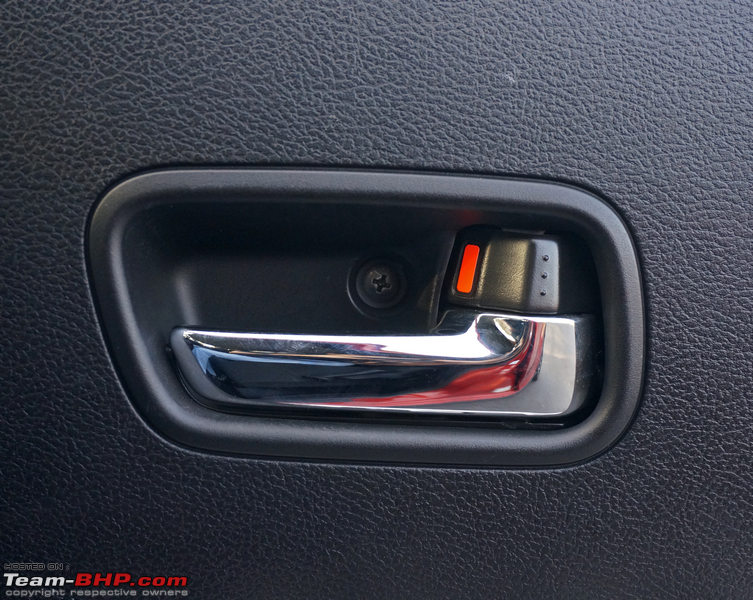 Same old console that has been appearing in Maruti cars since a long time. Only driver's window gets one-touch down functionality. No one-touch up / pinch guard functions provided. ORVM’s are electrically adjustable and foldable. Only the driver's window button is illuminated  Decently sized grab handles on the door are body-coloured with silver inserts on the sides:  Doorpads can hold a 1L bottle each. However,…  …the door pockets are not wide and can hold only small items:  Door sills are not wide and small scuff plates do not get any branding:  Front seats appear thin, but are well shaped and provide good support. Side bolstering is healthy and there is sufficient padding. Seats are slightly towards the softer side and may not be ideal for longer journeys. They are also not very wide and hefty occupants might find them a little too snug. The neck restraints are very tall and weird-looking and their cushioning is on the firmer side. Fabric upholstery is standard on all variants and the quality itself feels satisfactory:  Driver’s seat is 6-way adjustable. Lumbar adjustment has been omitted. Lever to recline the seat feels loose. For a moment I thought I was holding the height adjustment lever. Neither lever feels very durable. Height adjustment for the driver's seat only on the Alpha trim which means the AMT variants miss the most useful feature:  Fore & aft travel is good enough to allow even drivers with a laid back driving position to be comfortable:  Height adjustment range is healthy. Short or tall, no one will complain. Suhaas is 6'1" and with driver's seat at its lowest position, he had 4 inches of headroom:  A closer look at the fabric upholstery: 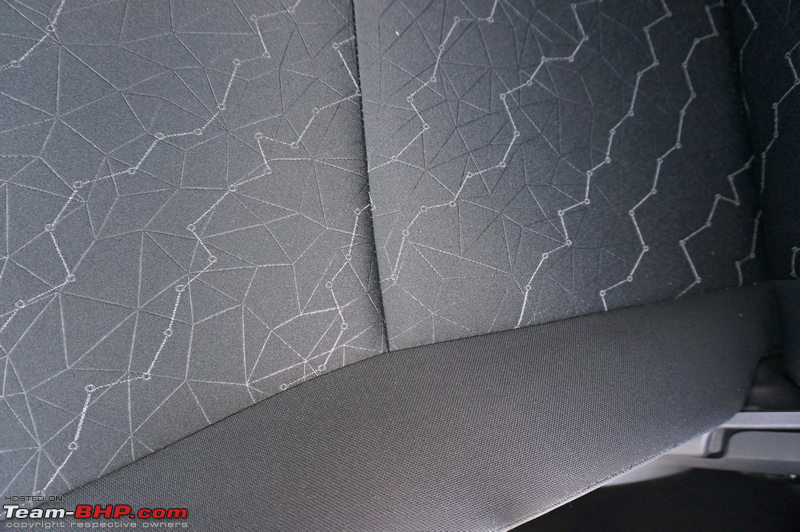 Passenger seat misses out on height adjustment:  Sturdy metal lever for fore & aft movement:  Seatbelts are not adjustable for height. Still, most users will find them placed at a comfortable height. They get pretensioners & load limiters:  Footwell is wide and standard Maruti A, B, C pedals are well-spaced out. Clutch is light, but travel is long. Dead pedal is small and its angle is not steep enough to provide a comfortable resting position for your left foot:  Fuel flap release is located on the floor, just ahead of the driver's seat. Notice how the floor mat is designed to ensure that it doesn’t foul with it. No boot release here. The hatch locks / unlocks with the central locking system:  A-pillar is black on the inside as well. It is not very thick and overall frontal visibility is good:  Shape of the ORVMs is identical to the Baleno's. They are sufficiently tall, but should have been wider:  IRVM is wide, but thick C-pillars limit rearward visibility. IRVM does not get auto-dimming function:  Thick C-pillars and small windshield restrict rearward visibility. Still, with the small dimensions and the reverse parking sensors and camera, reversing is not a difficult affair:  Center fascia gets a tablet-like touchscreen infotainment system with air-con vents on either side. The screen is offset towards the passenger side. Below it are the climate control buttons and the 12V power outlet and USB / Aux-in sockets. Notice the body coloured panel around the storage spaces and gear lever:  Sides of the center console are painted in the same colour as the car's body. The Suzuki Progressive Triad appears here as well. The body coloured elements in the cabin have evoked mixed reactions from the public. While some think it as an interesting element, others absolutely detest it. Interestingly, cars finished in Pearl Arctic White, Silky Silver, Glistening Grey and Urban Blue get Titanium coloured interior door handles and accents on the center console. The plastic on the sides of the center console is really thin and the whole console moves if you shake it with one hand:  Tablet-like touchscreen infotainment system sticks out in front of the dashboard between the two central air-con vents. It gets Bluetooth, USB and Aux-in connectivity and supports Android Auto, Apple CarPlay & MirrorLink. It has an SD Card slot for navigation as well. Its functions have been covered in a dedicated thread:  A look at how the infotainment system sticks out of the dashboard. While the job appears well-finished on the sides…  …integration with the dashboard could have been better at the top:  Center air-con vents are rectangular and come with chrome inserts. There are no air volume controllers provided and one cannot shut the air flow from these vents:  Hazard light switch is of good quality and its action feels nice: 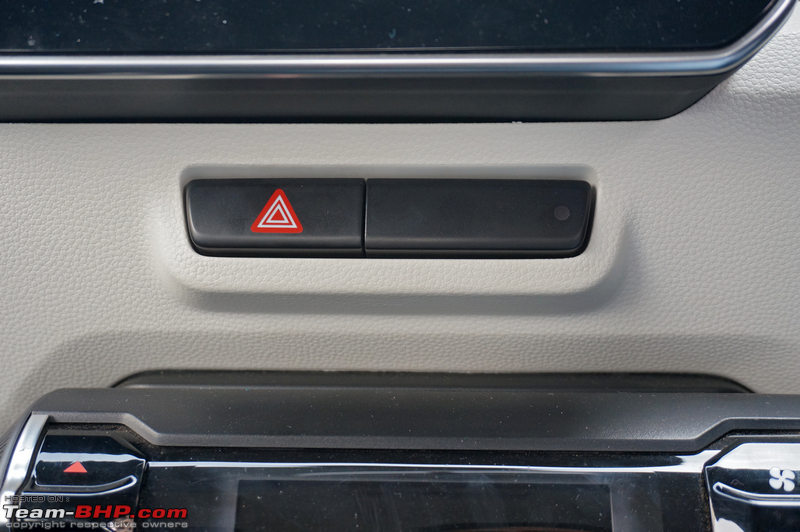 Red light keeps blinking when the car is locked, indicating that the security system is armed: 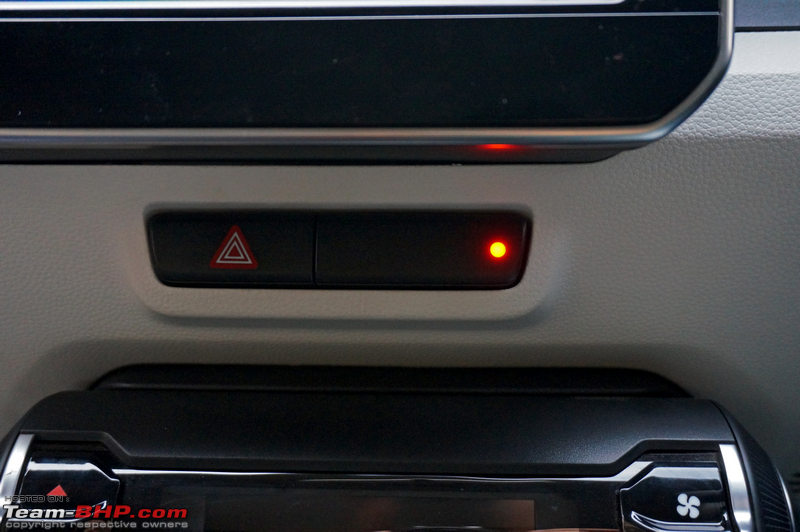 Climate control system performs well even on hot days. The climate control buttons on the Alpha trim are a highlight of the interiors. The climate control unit comes with silver inserts and has good quality toggle switches that look super funky. The temperature is adjusted by operating the glossy black toggle switch on left, while fan speed is adjusted via the switch on the right. The blower has 8 levels of adjustment. In levels 1 and 2, it is silent. At levels 3 and 4, it gets audible. At levels 5 and 6, it is loud, while on levels 7 and 8 it gets very loud. The lowest temperature that the system goes to is 18 degrees centigrade before hitting LO, while the highest temperature it goes to is 32 before hitting HI. Unlike the large switches for the blower and temperature adjustment switches that can be lifted up or pressed down, the smaller toggle switches located at the bottom of the system can only be pressed downwards. The air-conditioner can be started by using the "Auto" switch or by starting the blower and the hitting the "AC" switch. To stop the air flow completely, you have to use the "Off" switch. You cannot turn it off by reducing the blower speed to level 0: 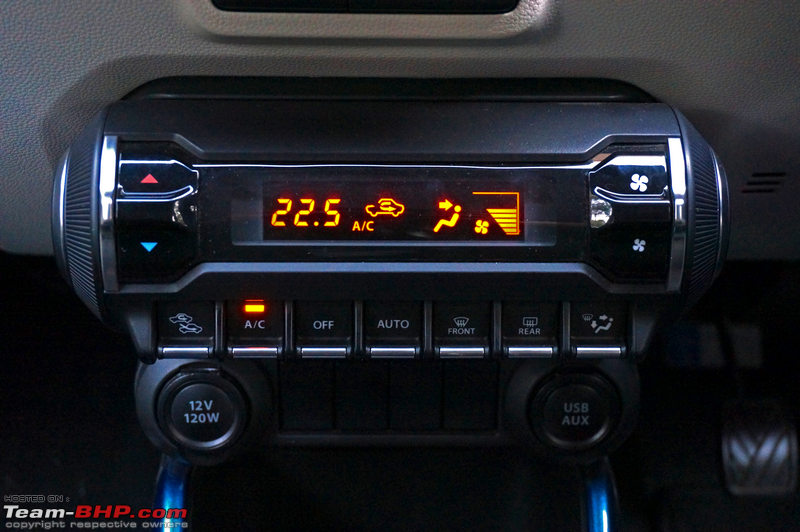 Climate control unit does not sit flush with the dashboard. The sides of the system sport a funky pattern and silver inserts: 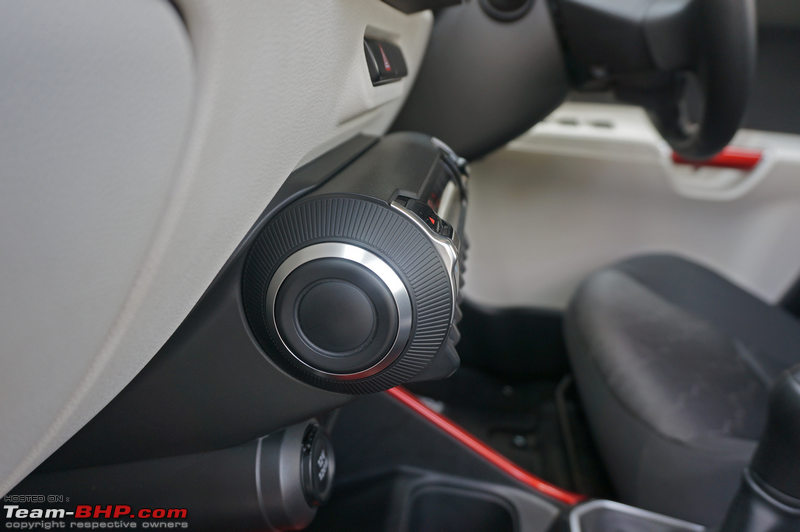 Apart from the top-end Alpha trim-level, all variants get a basic HVAC unit. While the knobs and buttons are easy to rear and operate, the whole unit, particularly the slider for the recirculation function looks ugly and horribly outdated: 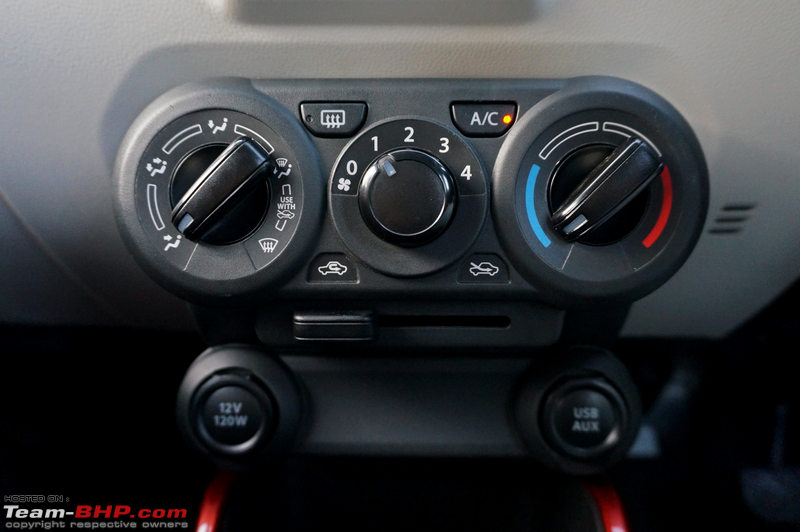 Plain-Jane HVAC unit of the lower variants looks weird and does not get any inserts or design pattern on the sides. Should have gotten a little bit of chrome: 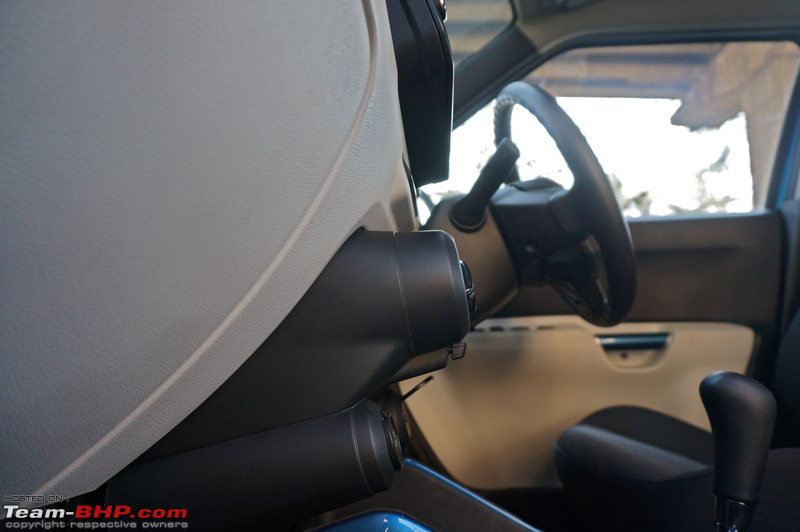 Intake hole for the air-con sits on the lower part of the dashboard just to the left of the steering wheel: 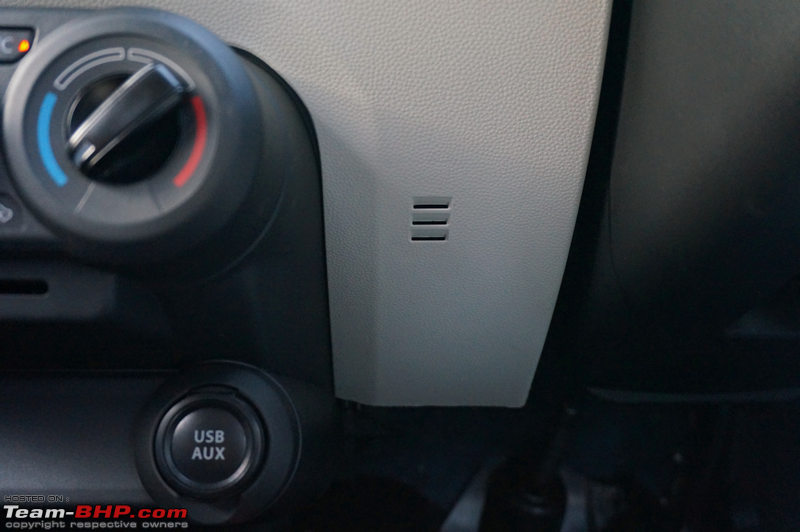 12V power outlet, USB and Aux-in ports are located below the air-con / climate control unit: 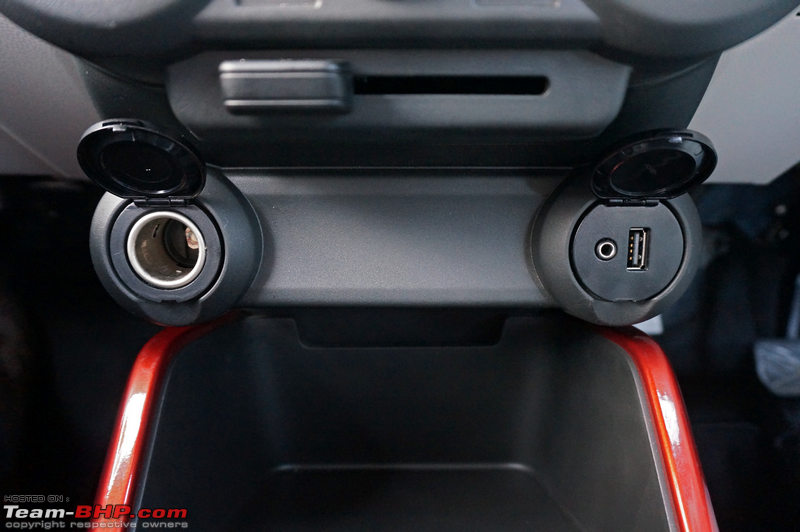 Plastic lids prevent dust from entering the sockets when not in use. Alpha variant gets button fillers between the ports. For the record, international versions get switches for driver assist features here: 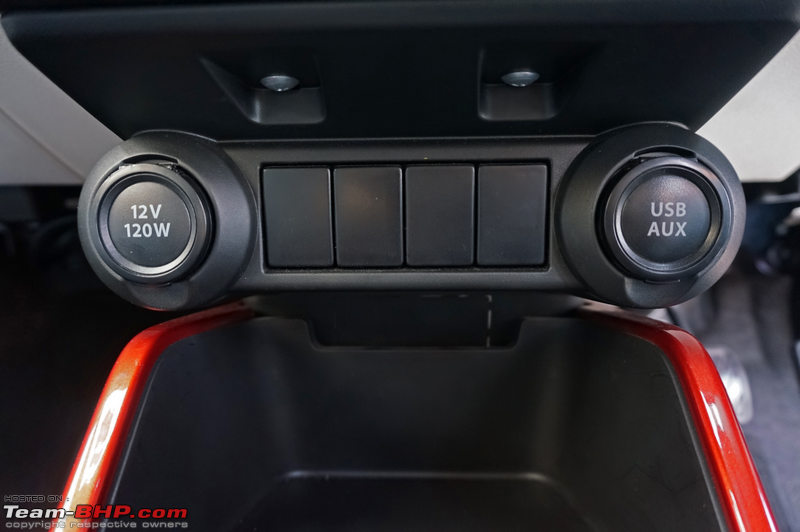 Storage space at the base of the center fascia can be used to place your smartphone: 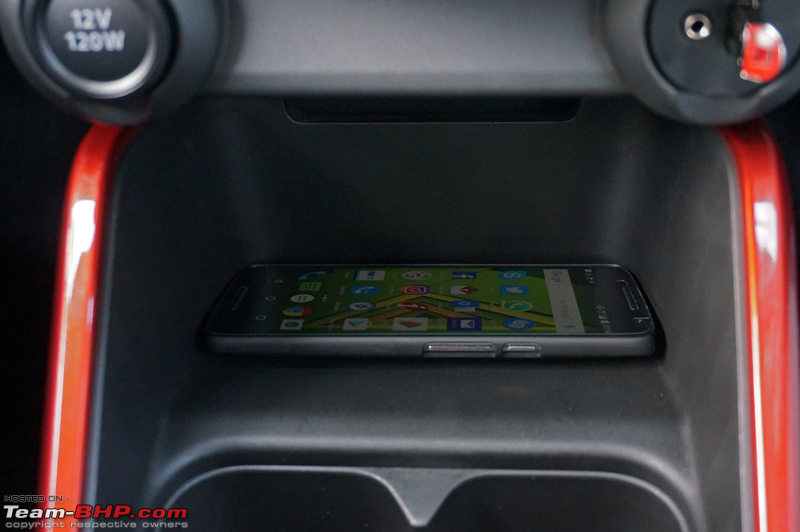 Center console gets a pair of cupholders. No, that's not a rubber lining on the base. 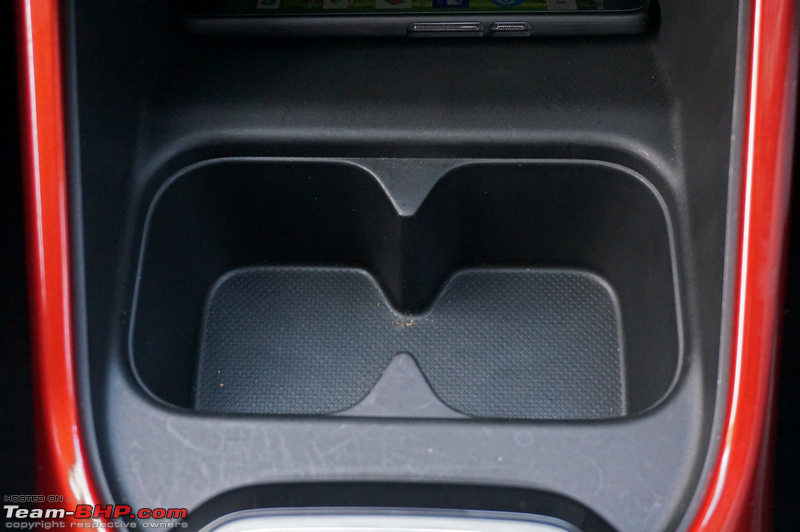 Bird's eye view of the handbrake console. No center armrest provided for the driver / front passenger: 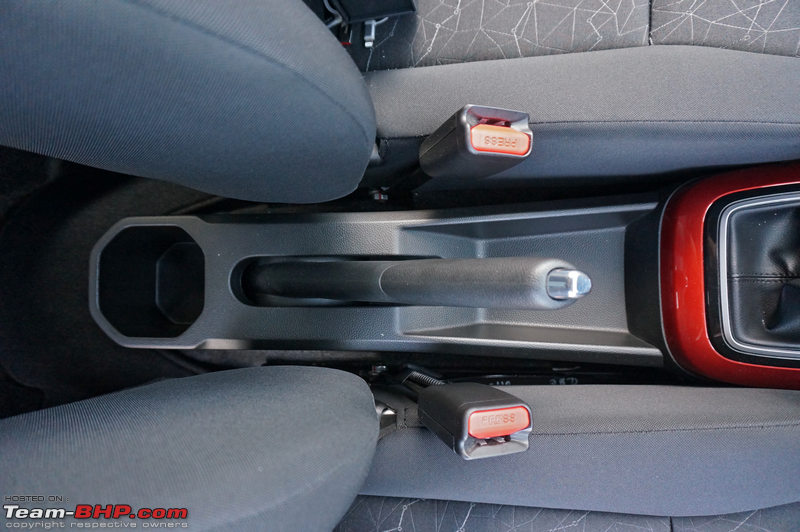 Shallow storage space below the handbrake can hold a 5.5" smartphone: 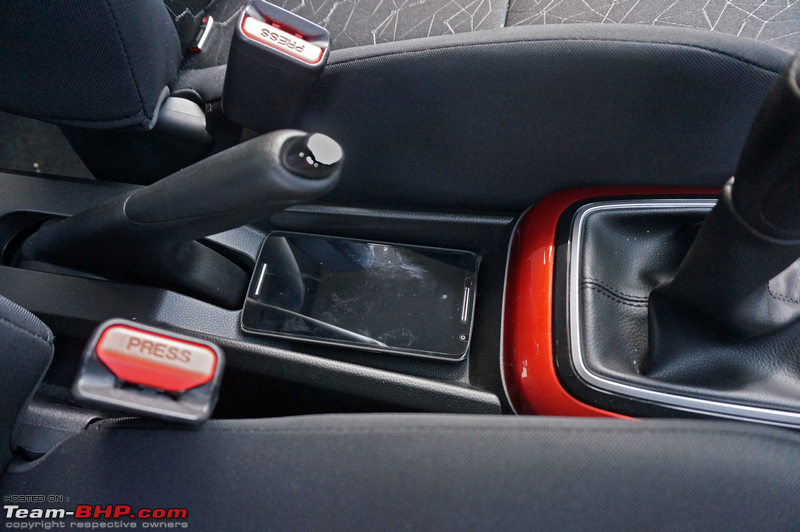 Recess above glovebox is not deep enough to hold anything. The smooth surface and absence of a lip means that even small items like pens and coins placed here will fall on the floor on acceleration: 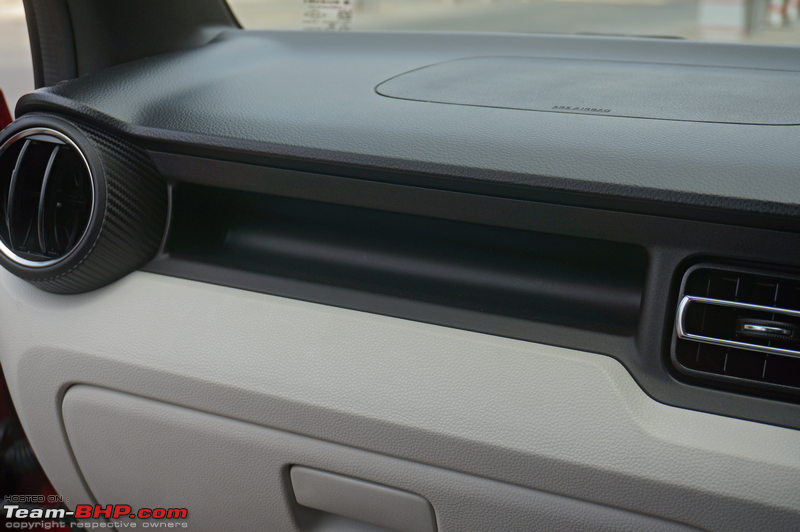 Glovebox is on the smaller side. It has two compartments, but no illumination or cooling function. The upper shelf remains in place when the lid is closed. So you can't keep anything large in the lower compartment as it will hit the lower surface of the upper shelf. The glove box lid feels flimsy to operate: 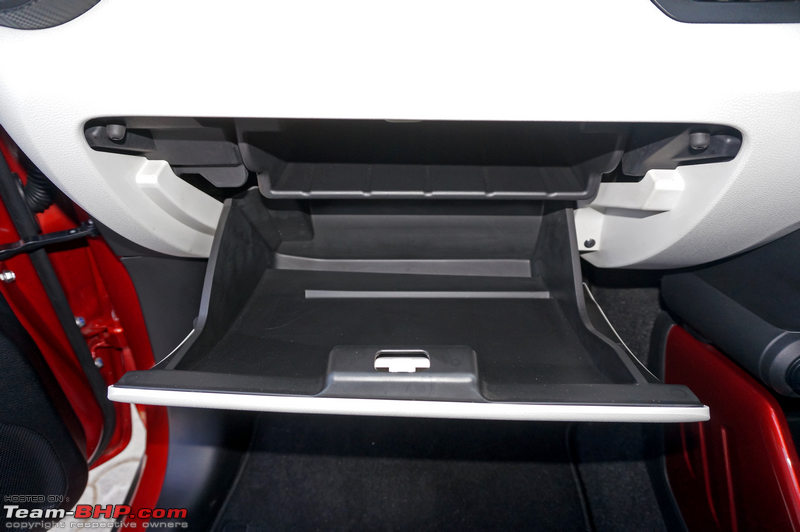 Sunvisors are economy-grade in feel. Driver-side unit merely gets a flap to hold tickets: 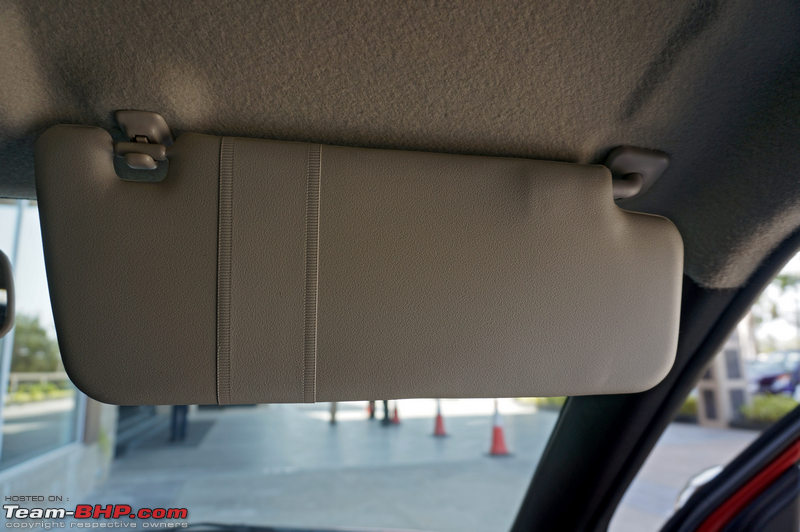 Passenger-side sun visor gets a vanity mirror, but there's no cover or light provided: 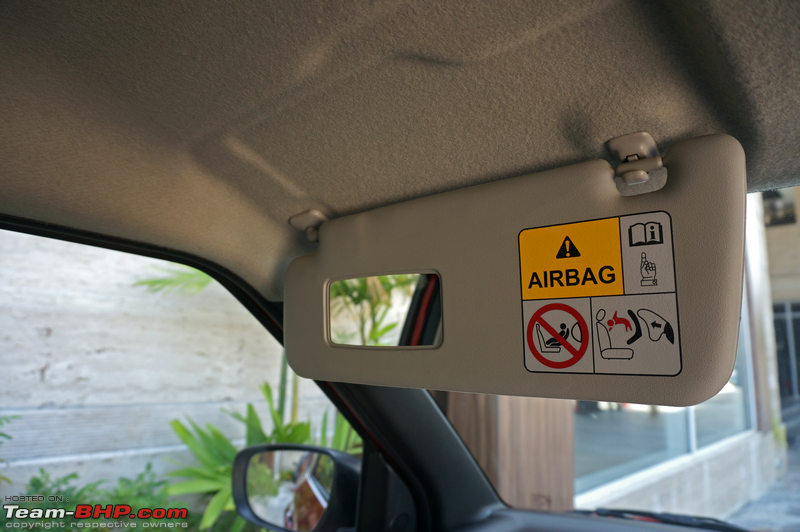 A single cabin light only at the front with no individual map lights. If you’re going to give only one light in the cabin, it should have been in the centre just above the front seats so both front and rear passengers can operate it. The cluster also houses the Bluetooth mic: 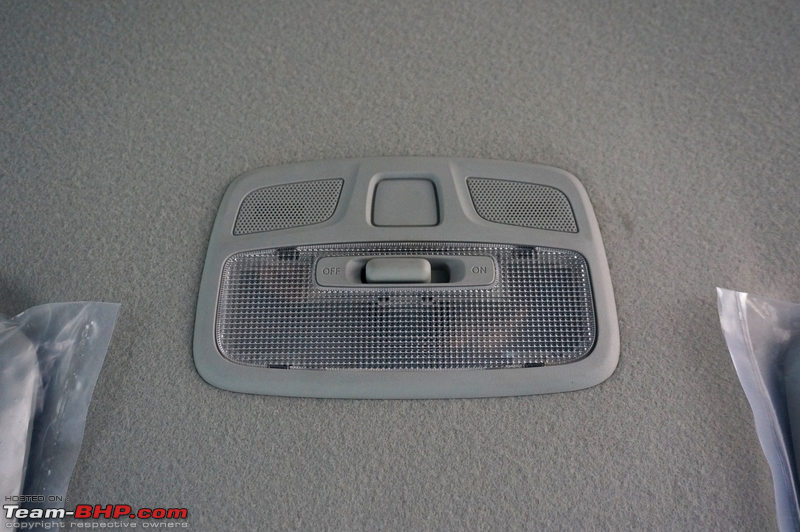 Ignis gets dual front airbags as standard. European version gets side and curtain airbags as well: 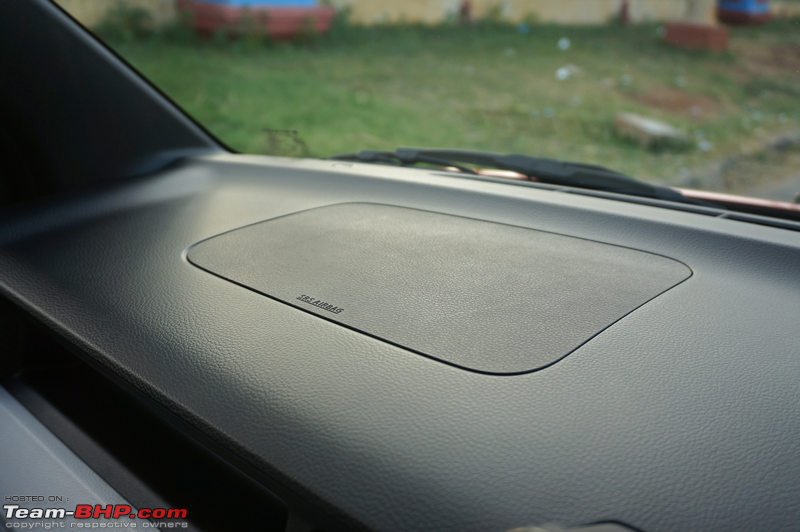 Last edited by Aditya : 20th June 2017 at 11:41. |
| |  (28)
Thanks (28)
Thanks
|
| The following 28 BHPians Thank Aditya for this useful post: | Avikbrio, CarguyNish, carrazy, daretodream, deetjohn, Gannu_1, GTO, InControl, Jaggu, Karthik Chandra, MSAneesh, Patriot_Vishwas, Ponbaarathi, PraNeel, RavenAvi, Redline6800, rohitoasis, romeomidhun, rshanker, samaspire, shancz, Sheel, Simhi, SmartCat, sunny29584, vb-saan, Voodooblaster, WAM-4 |
| | #5 |
| Team-BHP Support  | Interior - Rear  The rear doors open in a triple-stage action. They open sufficiently wide, and the high roof of the Ignis makes ingress easy. At the same time, the seat is placed at an above average height, which means you don’t have to sit down in it. This makes the car quite user-friendly even for senior citizens. Wide gap between the B-pillar and the seat makes it easier to step in & out:  Door sill is not very wide either, which means occupants do not have to move their feet over the sill when entering or exiting the car:  Rear door pads have a much smaller white area than the front ones. The white portion is concentrated only around the power window switches and door handles. No body-coloured door handles here. Door handle is placed a little too far back making it uncomfortable when opening / closing the door:  Bottle holders are smaller than the ones at the front and can hold only 500 ml bottles. There are no door pockets:  Rear bench is designed to accommodate 3 persons. However, only 2 adults and a child at the most will be able to sit comfortably as shoulder room at the back is very poor. The seat base is largely flat with no contours. Fabric upholstery is identical to the front seats. No center armrest provided:  Legroom looks generous and two six-footers can sit behind one another in reasonable comfort:  A look at the maximum and minimum legroom available in the rear:  With the front seat in my driving position, I have about 4 inches of knee room. With the front seat in the full forward position, the knee room is around 12 inches. If front seats are moved all the way back, my knees almost touch the seatback. However, it is soft and scooped out, so it does not hurt. Additionally, there is space below the front seats which enables you to slide your feet under them:  Seatbacks of the front seats are scooped out, which helps in freeing up some more knee room for the rear seat occupants:  Only the passengers on the sides get headrests and 3-point seatbelts. Center passenger gets only a lap belt:  Rear seat is at a decent height and offers average under thigh support. Typical to most Maruti’s, the seat base has been shortened to give the impression of more legroom. This however means under thigh support for tall people is reduced. The backrest is also a little too upright. Headroom is good though; at 5'10", I had ~3" of clearance. Overall space is good and the seat cushioning is on the softer side:  Headrests are adjustable, but have only two positions - all up or all down (nothing in between). They are soft and properly sized though:  Middle passenger gets only a lap belt. Seatbelt buckles are housed in dedicated cut-outs in the rear seat:  ISOFIX child seat anchors have been provided on both sides:  Triangular body-coloured metal portion is located at the base of the quarter glass. The window sill is high and the top of the window is rather low compared to the height of the roof. Taller occupants will find themselves having to bend down to look outside the window. Glass area is not very large and the upholstery is dark. However, the available space prevents people from feeling claustrophobic in the rear:  Rear window can be rolled down all the way...well, almost:  Only front passenger seat has a seatback pocket. It is not deep, but adequately wide:  Spring-loaded grab handles above each passenger door have a damped action. No coat hooks provided:  C-pillar is HUGE. Notice the recess on pillar in which the seat belt is mounted:  No cabin light for the rear seat occupants:  No air-con vents or charging points for the rear passengers, just this bottle holder located at the end of the center console:  Floor hump is about 3 inches high and not very wide. Middle passenger will find it comfortable to put his feet on either side of the hump:  Boot can be unlocked by using the unlock button on the console on the driver's door or pressing the unlock button on the keyfob or using a lock/unlock button on the hatch. It can be opened only by using the electromagnetic release. 260 liters of boot space is more than that of the Swift’s:  Useable space is good enough to accommodate small to medium size bags thanks to suspension components that aren’t intrusive:  Parcel tray is recessed to prevent things from rolling off:  For increasing luggage space, the rear seats can be folded down. Pull this knob up to unlock the seatback and fold it (there's another knob on the other side):  Rear seat is split in a 60:40 ratio which allows selective folding if you need to carry a combination of cargo + passengers:  A look at the rear seat with both the seatbacks folded:  Folding the seatbacks of the rear seat gives you cargo capacity of 415 liters but the seats don’t fold f-l-a-t:  Loading lip is high and one will have to make an extra effort to load luggage. But, thanks to the split tail-lamps, the boot opening is wide making luggage easier to load:  Tailgate gets a full black plastic cladding on the inside. No cost-cutting here:  Tailgate is held up by two pneumatic struts:  Black roof effect continues on the frame of the car underneath the tailgate:  The effect is created by a vinyl sticker and not actual paint:  Maruti has done a good job of concealing most of the wiring. However, some ugly bits like this demister connector stick out like a sore thumb. There's one on the other side as well. A plastic cap should have been used to cover them:  Boot light (with switch) located on the left:  Rear strut mounting point can be accessed by removing the plastic cladding on either side of the boot:  Top tether for the child seat:  Hole to put your finger in and lift the spare wheel cover:  Spare wheel is a steel unit with a full-size 175/65 R15 tyre:  No Styrofoam casing or dedicated slot provided to tuck away toolkit. Kit consists of the regular tyre-changing tools, safety triangle and first-aid kit:  Last edited by Vid6639 : 22nd April 2017 at 10:28. |
| |  (34)
Thanks (34)
Thanks
|
| The following 34 BHPians Thank Aditya for this useful post: | ach1lles, akshay81, Avikbrio, CarguyNish, carrazy, daretodream, deetjohn, Gannu_1, GTO, IN07KL0484, InControl, Jaggu, Karthik Chandra, lemedico, Leoshashi, MSAneesh, Patriot_Vishwas, Ponbaarathi, RavenAvi, Reinhard, rohitoasis, romeomidhun, rshanker, sairamboko, samaspire, shancz, Sheel, Simhi, SmartCat, subhro1988, sunny29584, theexperthand, vb-saan, WAM-4 |
| | #6 |
| Team-BHP Support  | In-Car Entertainment The Alpha (top) variant of the Maruti Ignis gets a tablet-like SmartPlay touchscreen infotainment system, which offers smartphone connectivity with Android Auto, Apple CarPlay and Mirror Link. Music is played through 6 speakers (including 2 tweeters). Connectivity is through Bluetooth, USB and Aux. A CD player is missing though. The system also comes with navigation and voice recognition & serves as a screen for the reversing camera. Tablet-like 7-inch touchscreen is placed high on the dashboard - this means that the driver does not have to look too far down to glance at the screen. It looks weird - like something that was pasted on in the aftermarket. No chance of fitting aftermarket HUs here. The system is very easy to operate, but visibility under direct sunlight is average. While the screen is pretty sensitive to scrolling and clicking, there is a little lag. It is not as quick as scrolling on a mobile phone. The head-unit's interface is now a familiar sight on Maruti cars. The home screen is divided into four sections:  Delta and Zeta variants do not get a touchscreen system. Instead they come with a basic audio system that looks terribly out of place as it's made to fit into the same slot as the Alpha's larger touchscreen. The unit does support Bluetooth, USB, Aux and gets a CD player:  In the Alpha and Zeta variants, music is played out through 6 speakers (including 2 front tweeters). The Delta gets only 2 speakers:  Tweeters placed on the A-pillars create a pretty high sound stage. Feels like the music is coming from ear level rather than footwells:  Music can be played from a variety of sources (including SD Card):  The interface is simple and easy to operate. Font size is large as well, making it easy to read on the go:  You can browse through your play list according to the name of the song, artist, album or genre:  A variety of settings can be altered to suit the user's preferences:  Sound settings include the usual equaliser settings and fader / balance adjustments. For a car of this segment, the bass is very full and rich although once you go past a volume of about 22 on a scale of 30 there is noticeable distortion in the bass. So for low to medium listening volumes, the system is impressive. The sound quality is good all-round the listening range. Usually in this class, the systems lack mids or bass, but this has a wholesome sound. You might even want to turn the bass down by one level in the equaliser settings. The highs are very well placed and crisp & clear, while the mids are powerful and do a good job of bringing out the vocals of any track. We would give the sound quality a solid 8 / 10. It could get a higher rating if it could hold its own at higher volumes:  A number of presets are also provided:  One can even set the level of the speed dependent volume control…  …and the brightness of the touchscreen:  There is an option to connect an external DVD player as well. Additionally, the system can play video through other inputs (e.g. USB) as well. The resolution of the display is very good:  You have to 'confirm' each time before using the navigation system. This can get rather irritating:  Navigation is via pre-loaded maps on an SD card:  Maps provided by Nokia HERE. Interface is standard fare but the system sent us in the opposite direction once. I had to pull out my mobile phone and switch on Google Maps to get back on track:  Pairing with your smartphone is quick & easy:  Lists include call history and contacts. Phone clarity is good:  Incoming text messages are displayed as well:  Voice commands work well. They can be used to make phone calls, play media files and set destinations in the navigation system:  Android Auto is being offered on a Maruti car for the first time. To use it, users have to connect their smartphones to the system via a USB cable:  Android Auto allows users to control multimedia functions via voice commands. One can also access other apps such as listen to WhatsApp messages:  Users can get directions, make calls, send and receive messages, listen to music and audio books through a touch interface:  Navigation through Google Maps was more accurate than the SD Card-based inbuilt navigation system. Android Auto also helps in getting real time traffic updates via Google:  Parking display is clear with colour-coded distance demarcations. However, it does not get adaptive guidelines. That said the camera along with the reverse parking sensors help greatly while backing up since the rearward visibility is limited:  Reversing camera is effective at night as well:  While the Delta and Zeta variants get a remote control for the audio system, owners of the Alpha variant can download the Suzuki SLDA Remote App on their smartphones, connect it to the infotainment system via Bluetooth and use their phone just like a remote control:  Last edited by Vid6639 : 22nd April 2017 at 10:16. |
| |  (30)
Thanks (30)
Thanks
|
| The following 30 BHPians Thank Aditya for this useful post: | ach1lles, AdityaDeane, Avikbrio, CarguyNish, carrazy, Chrome6Boy, deetjohn, Gannu_1, GTO, InControl, Jaggu, Karthik Chandra, lemedico, Leoshashi, Patriot_Vishwas, Ponbaarathi, Rajeevraj, RavenAvi, rohitoasis, romeomidhun, rshanker, sairamboko, samabhi, samaspire, shancz, Sheel, sunny29584, swiftnfurious, theexperthand, WAM-4 |
| | #7 |
| Team-BHP Support  | Driving the 1.2L Petrol MT Familiar 1.2L K12 engine found in many other Maruti cars. Even with a small engine bay, empty spaces are visible. Notice that the petrol doesn't get an engine cover:  The Ignis petrol draws power from the same 1,197cc, 4-cylinder K12 petrol engine with variable valve timing technology (VVT) as the Swift, Baleno and Dzire. However, here it produces 82 BHP @ 6,000 rpm and 113 Nm of torque @ 4,200 rpm, which is 1 BHP lesser than the Baleno and 2 BHP lesser than the Swift and Dzire. The torque produced is also lesser by 2 Nm compared to its siblings and produced 200 rpm higher. With a kerb weight of merely 825-860 kilos, the Ignis has a power-to-weight ratio of 99 BHP / ton and torque to weight ratio of 137 Nm / ton. Both these figures overshadow all the B2 segment cars like the Grand i10 and the Elite i20. Due to the lighter weight the power to weight ratio of the Ignis is even better than its elder sibling, the Baleno. To start the engine, the MID asks you to press both the clutch & brake, then hit the engine start / stop button. But the engine will still fire up with just the clutch depressed. Once fired up, there are no vibrations felt on either the steering, pedals or the gear lever. In general, the refinement of the engine at idle is very good. However, a slight shake can be felt on the seat occasionally. As we have seen earlier, the 1.2L K-series is a gem of a motor and the Ignis is the lightest car to use it in the Maruti stable. Therefore, the engine feels more sprightly than it does in other Maruti's. Throttle response is very crisp. The Ignis moves off from a standstill easily and offers good driveability in the city. The engine's low rpm behaviour will satisfy most drivers and you can potter around town in 5th gear at 50km/h with the engine ticking over lazily at 1,500 rpm. There is adequate power on offer and even when you need to close a gap quickly, you won’t feel the need to downshift. Keeping up with city traffic is no trouble for the 1.2L petrol. This low-speed behaviour coupled with small size, light controls, good frontal visibility and sorted ergonomics make the Ignis a very good car for driving in the city. Take the Ignis out on the open roads and one can really enjoy the performance that the 1.2L unit offers. Power delivery is linear in nature and the rev-happy engine is refined throughout the rpm range. The engine feels very responsive above 2,500 rpm and accelerates strongly all the way to the redline. 1st gear maxes out at 48 km/h with second good till 88 km/h till the rev limiter kicks in. Along with the spirited performance, the 1.2L engine sounds sweet, and enthusiasts will enjoy pushing it hard. The strong engine makes the Ignis a good performer on the highway. The only downside is that Maruti has set the max engine rpm to a very conservative 6,300 rpm. You get the feeling that the engine has a few hundred rpms left in reserve when you (unexpectedly) hit the rev limiter in the middle of an overtaking maneuver. This will force you to upshift, losing time in the process. The Ignis can cruise on the highway in 5th gear at 100 km/h with the engine turning over at 2,600 rpm. While there is sufficient power throughout the rev range, it’s best to shift down a gear or two while overtaking on single lane highways to keep the Ignis in the meat of its power band. The clutch is very light and pressing it takes close to no effort. However, we found the travel to be on the longer side and take a bit of getting used to. The 5-speed manual gearbox is smooth to operate with short throws. It’s precise so you will never miss a gear or slot into the wrong one. The gearshift quality along with the rev happy nature of the petrol engine makes this combination the perfect choice for enthusiasts. Despite the light kerb weight, the Ignis petrol has an ARAI rating of 20.89 km/l, which is lower than the Baleno's figure of 21.4 km/l. This is probably down to the boxy shape and slightly higher cruising rpms. Coming to NVH levels, the Ignis does very well at slow speeds and around town. The engine is barely audible in city rpm's. But when you climb up the revs you realise Maruti has skimped on the insulation materials. At high rpm’s, the engine is more audible than you would expect. While this might appeal to enthusiasts, regular folks are not likely to be impressed. At speeds above 100 km/h, road and wind noise start creeping into the cabin too. These get louder as the speed increases. There are some vibrations felt on the steering wheel as well as the gear lever at higher rpm’s. Free-revving petrol engine features variable valve tuning technology and produces 82 BHP and 113 Nm of torque:  Both - the petrol and diesel get an insulation sheet under the bonnet:  Remember the vents on the sides of the bonnet. Well they are fake and have no holes for airflow. Here's how they look from the inside of the hood:  Firewall gets insulation sheet as well. It isn't enough though. The quality of insulation isn't to our satisfaction:  No underbody protection. You can see the ground below clearly:  VIN is stamped above the firewall and visible through a cut-out in the plastic cladding:  5-speed manual gear lever is shared with other cars from the Maruti stable. It is smooth and a joy to operate:  Gear lever gets a faux leather boot:  Driving the 1.2L Petrol AMT Magneti Marelli-sourced AMT unit sits on top of the gearbox and is easy to access:  Apart from the 5-speed manual transmission, the 1.2L petrol engine can be had with a 5-speed automated manual transmission. The 5-speed AMT unit is sourced from Magneti Marelli and is being offered only on the Delta and Zeta (mid) variants at present. This is the first time that Maruti has used this engine - transmission combination. The Baleno and Dzire, which share this engine, use a continuously variable transmission (CVT) and a 4-speed torque convertor unit respectively. The AMT mechanism is a simple bolt-on job and it uses the Ignis MT's existing gearbox. It’s pretty straightforward in the way it works. Mechanically, the AMT gearbox is identical to the Ignis’ manual transmission. What's different is how the clutch is operated and how the gears are shifted. In the manual, the driver is responsible for these tasks. With the AMT, hydraulic actuators located in the engine bay operate the clutch and shift gears. There's no clutch pedal, and zero driver input is required for gearshifts, making it exactly like a conventional automatic to drive. Simply put, the mechanical functions of operating the clutch and gear lever have moved from inside the cabin to the engine bay. To know more about AMTs & how they work, click here. AMTs, as we know, are cheaper to build than proper automatic gearboxes (torque converters, dual clutches). This allows Maruti to price the Ignis AMT lower (Delta Rs. 5.74 lakh; Zeta Rs. 6.30 lakh) than other automatic hatchbacks like the Grand i10 (Magna Rs. 5.99 lakh; Sportz (O) Rs. 6.83 lakh). Maruti certainly knows the market well. Compared to the MT, the Ignis AMT carries a premium of Rs. 55,000 which is why the AMT versions end up looking as better VFM vs other AT hatches. The Baleno for example commands a 1.1 lakh premium for it’s CVT box. Maruti could have used this to their advantage by offering the AMT in the top spec Alpha trim which would still undercut the competition. The AMT has the standard N, R, D and M positions. There is no 'P' (park) mode or gear unlock button like in a conventional AT. To start the car, the gear shifter has to be in N (neutral) position and the driver's foot has to be on the brake pedal. It is only when these conditions are met that the engine will crank. The Ignis AMT has no problem rolling off from standstill. Throttle response when starting off is very good. The AMT functions like a regular automatic gearbox and, as the driver doesn't need to press a clutch pedal or shift gears, it results in a stress-free drive. Additionally, putting the car in D / M mode and releasing the brake pedal will result in the Ignis creeping forward without any accelerator input. In bumper to bumper traffic, you can drive the Ignis with only one pedal (i.e. the brake). Without any throttle input, the car will keep moving at ~7 km/h. In general, keeping up with urban traffic is easy. However, the gearbox suffers from slow gearshifts (particularly during upshifting) and there is a delay of a second or so from the time one gear is disengaged and the next one is engaged. This results in a jerk and as we've noticed in other AMTs - the lull in acceleration makes your head bob forward. If the car is being driven in a relaxed manner, things are smooth (although you will still notice each gearshift). The gearbox's operation is silent too. It's only when the driver gets aggressive with the throttle that things get jerkier resulting in your head swaying back & forth. If you've experienced a torque-converter or dual-clutch automatic before, you'll be put off by the AMT. On the other hand, if you are new to the world of automatics, acceptability will be easier. It is important to note that, while every upshift from 1st to 3rd gears is felt, the shifting between 4th and 5th gears is smoother. There is a way of reducing these jerks. When accelerating up to speed, let off the accelerator at intervals. The AMT will seize that opportunity to upshift. Overall the larger K12 engine is a better combination with the AMT vs the AMT + K10 in the Celerio and Alto. The larger motor masks the shortfalls of the AMT significantly. The AMT and K10 engine combination is jerkier and because the smaller engine is down on power and torque the gearbox has more work to do. On the open road, the AMT is much more at ease with a relaxed driving style than an aggressive one. It works well for a driver who prefers to build up speed gradually. The engine has enough grunt to keep the Ignis running at triple digit speeds all day long and with a light foot, the transmission is also smoother. Driving in D mode is good on the highway as long as you are happy to cruise. Speaking of which, she cruises at 100 km/h in 5th gear at 2,800 rpm. Put your foot hard down and the engine revs to 6,000 rpm before the transmission shifts up. What is noticeable is the way the revs jump up when the driver slams the throttle to match the revs in the lower gear while the transmission eagerly shifts down. The shift, however, is nowhere close to being as quick as a DSG. That said, the response time is not as slow as some other cars with AMT. It is quite acceptable for expressway driving. Even then, it's best to use the manual mode while overtaking slower cars on undivided highways. The AMT comes equipped with 'Manual mode' that can be engaged by moving the gear shifter to D, and then to the left. Pull the shifter down to upshift and push it up to downshift. In M mode, the transmission does not upshift on its own. Driven hard, the engine will rev to 6,300 rpm. It will not allow you to upshift either if it finds the revs too low. It will also not downshift unless the revs fall drastically. M mode comes in handy when one wants to overtake quickly. While the response time is far from instant, it's still a bit faster than D mode. M mode is useful to bring the engine into its powerband before an overtaking maneuver & also during the actual overtaking (to prevent the AMT from an unintentional + slow upshift while you're overtaking). Another time when the M mode can be used is when you desire engine braking. Driving downhill, this mode aids engine braking which in turn, reduces the workload on the brakes. It must be mentioned that there is a slight delay between the time you tap the gear lever and the gearshift actually happening, resulting in a jerk. Therefore, even in this mode, it is advisable to let go off the throttle for an instant while upshifting, just like you would do in the case of a conventional manual transmission. NVH levels are identical to those of the MT. A slight buzz can be felt on the gear shifter at high rpms. AMT shifter is lifted straight from the cheaper Celerio. Shift actions are average and feel like any other AMT though the larger 1.2L engine masks the AMT’s inherent flaws to an extent:  The gear console is finished in piano black. Like other AMT’s, there’s no "P" mode:  No clutch pedal means more space in the footwell. Dead pedal could have been wider and a little more raised to make it more comfortable to use:  AMT's MID gets a gear indicator. The car cannot be started unless neutral (N) has been engaged The "D" next to the "1" denotes "automatic" mode, while the "M" denotes "manual" mode. Currently selected gear is shown in both, automatic & manual modes. Unlike the regular manual, there is no gear shift indicator. The transmission allows you to shift up to 2nd gear when the car is standing still:  Last edited by Rehaan : 18th April 2017 at 18:11. |
| |  (26)
Thanks (26)
Thanks
|
| The following 26 BHPians Thank Aditya for this useful post: | Avikbrio, BaCkSeAtDrIVeR, CarguyNish, carrazy, daretodream, deetjohn, GTO, InControl, Jaggu, MSAneesh, Patriot_Vishwas, Rajeevraj, RavenAvi, Rehaan, rohitoasis, romeomidhun, shancz, Sheel, Simhi, suhaas307, sunny29584, swiftnfurious, theexperthand, vb-saan, vibbs, WAM-4 |
| | #8 |
| Team-BHP Support  | Driving the 1.3L Diesel MT Fiat-sourced 1.3L DDiS engine needs no introduction, shared with many other cars from Maruti and other manufacturers. This engine fills up the engine bay more than the petrol. It’s also beginning to show it’s age now compared to it’s competition:  The Ignis diesel is powered by the same 1,248cc, 4-cylinder diesel engine found in many cars from the Fiat, GM, Maruti, and Tata stables. Maruti calls this unit the DDiS 190. It features a fixed geometry turbocharger with an intercooler and common rail direct injection technology. It develops 74 BHP @ 4,000 rpm and peak torque of 190 Nm @ 2,000 rpm, which is identical to the Baleno, Swift and Dzire. Once again, it's the Ignis' lower kerb weight of 940-960 kilos that gives it a better power to weight ratio (79 BHP/ ton) and torque to weight ratio (202 Nm / ton) than its siblings. While the Ignis diesel has a better power to weight ratio than most cars in the B2 segment, cars like the Ford Figo, Honda Jazz and VW Polo manage to match or better its figures since they have larger displacement 1.5L engines. Like the petrol Ignis, you have to depress the clutch and hit the engine start button to fire up the engine. On startup there is a slight shake and mild vibrations are felt on the gear lever and pedals. The familiar clatter of the diesel is very clearly audible inside. With Maruti having used this engine for so many years and in so many vehicles, we expected better insulation from noise and vibrations. Off the line, the car moves off without any effort. There is a little turbo lag, but even at low rpm’s it’s not dead. In fact you can even get moving from standstill in second gear without stalling. One can easily potter around town at 30 km/h in 3rd gear at 1,000 rpm, without the engine feeling like it’s being lugged. Maruti has done a good job of tuning the engine in a manner that it is quite acceptable to drive in the city. Things change when you need to close gaps quickly. Put your foot down and the lag is felt. Throttle response is not as sharp as the petrol car either. In such situations, you definitely need to downshift. Hatchbacks such as the Nissan Micra diesel offer better driveability. The Ignis' engine starts coming into its stride from 1,500 rpm and you feel the turbo kicking in after you cross 2,000 rpm. On the open road, the Ignis diesel is no slouch but neither can we say it is exciting. The engine revs to a max of 5,300 rpm with the Ignis reaching max speed of 45 km/h in 1st and 80 km/h in 2nd gear. But you won’t really like to rev the engine hard till the redline. All the action is concentrated in the mid-range between 2,000 - 4,000 rpm. Beyond 4,000 rpm, the power starts tapering off and at high revs the engine makes you feel aware that it’s strained. Additionally, beyond 3,000 rpm, the noise from the diesel engine begins filtering into the cabin and starts getting loud which can be tiring on longer journeys. The car is at its best if you build speed gradually and cruise on the highway. In 5th gear when doing 100 km/h the engine is ticking over at 2,200 rpm and at 120 km/h it’s at 2,600 rpm. On the expressway, you will not find the need to downshift while overtaking. It’s only when you are on an undivided highway and the speed and rpms drop considerably, that you will find the need to downshift. In general, you always get the feeling that the 1.3L oil-burner has adequate power and torque to keep the average Joe happy, but enthusiastic drivers will definitely look elsewhere. The clutch is light, but its travel is long. Like all other cars that use this engine, the Ignis Diesel MT gets a 5-speed manual gearbox. This unit is light to operate, its throws are short and gates are well defined. However, compared to the Swift, we felt it was little rubbery and not quite as slick. Coming to NVH levels, the diesel clatter and engine noise filtering into the cabin are certainly more than what you'd expect in a modern hatchback. Besides, the 1.3L powerplant is now feeling old and as I have said earlier, above 3,000 rpm, the engine noise is loud and beyond 4,000 rpm, it starts sounding and feeling rough. When driving at higher rpms, you will notice some vibrations on the steering wheel, pedals and a buzz in the gear lever. Vibrations are also felt inside the cabin when you turn off the engine. Like the petrol, wind and road noise start creeping into the cabin beyond 100 km/h. Concentrate hard and you will also be able to hear a whine from the transmission as well. The Ignis diesel's ARAI rating is 26.80 km/l, which is again not as good as the heavier Baleno's 27.39 km/l. In a mix of urban & highway with sedate as well as some aggressive driving, we managed to get about 16 km/l. For some reason Maruti has given the Ignis a tiny 32L fuel tank. This coupled with the lower fuel efficiency figure means that the overall range of the car on a full tank is lesser than the Baleno’s. Diesel engine gets an engine cover. It features a fixed geometry turbocharger and develops 74 BHP and 190 Nm of torque:  No underbody protection for the diesel either:  5-speed manual gear lever is shared with the petrol. The shift actions are not as smooth though and feel rubbery:  Manual variants do not get a gear indicator. However, they do get a shift indicator which tells the driver to shift up or down to obtain better fuel economy:  Intercooler is located at the front towards the right side of the engine bay:  Fuse box sits to the extreme left of the car in the engine bay, next to the battery:  Diagram under the cover of the fuse box to guide users:  Driving the 1.3L Diesel AMT Like the petrol, the diesel variant of the Ignis is also available with a Magneti Marelli-sourced 5-speed automated manual transmission (AMT). However, unlike the petrol, Maruti has used the combination of the 1.3L diesel engine and AMT before - in the Dzire compact sedan. AMT unit is placed at the same location as the petrol variant's:  Priced at Rs. 6.94 lakh for the Delta variant and Rs. 7.46 lakh for the Zeta variant, the Ignis diesel AMT also commands a premium of Rs. 55,000 over the MT. What's interesting is that it is the only diesel hatchback in the segment with the option of an "automatic" gearbox. The working and behaviour of the AMT is absolutely identical to the one in the Ignis petrol, explained in the earlier post. Starting the car requires you to put it in N, pressing the brake and hitting the starter button. On startup, there is a slight vibration felt in the gear shifter as well as some cabin shake. Moving off from a standstill is not a problem for the diesel AMT. However, it is not quite as instant as the petrol. The throttle response is duller as well. As we have seen earlier, the AMT functions just like a regular automatic gearbox, and the driver doesn't need to press a clutch pedal or shift gears manually. Again, engaging D / M mode and releasing the brake pedal will see the car creep forward without use of the accelerator - very useful in stop & go traffic. Without any throttle input, the Ignis diesel AMT will keep crawling at 8 km/h. The creep function works in reverse gear as well. In urban conditions, keeping up with the traffic will not be an issue. However, even with a light foot, the gearbox does not shift up from 1st to 2nd gear before the revs cross 2,000 rpm. As the throttle response is dull, you will feel the need to press the accelerator more than the petrol to get the car moving. As the engine suffers from turbo lag, all the power feels like it is delivered in a lump. When the traffic in front slows down and you have to release the accelerator, the revs drop quickly and the jerk felt is very annoying. This makes the experience even more unpleasant as you have to deal with the AMT jerks during shifts as well as when you release the throttle. The AMT also has some weirdness. Say, you take your foot off the accelerator just as the turbo has spooled, the car will still accelerate for a second. This takes some getting used to. There is no such issue with the petrol AMT. It is best to drive the car in a sedate manner as aggressive driving only makes matters worse. The back and forth motion caused by the jerkiness of the AMT along with the dull throttle response and turbo lag could prove to be quite a deal-breaker for the Ignis. Just like the petrol, the jerks can be reduced by lifting off the accelerator at intervals and allowing it to shift up smoothly. The petrol AMT seems to be the better option if you’re going for the AMT as it’s smoother than the diesel. On the highway as well, the AMT is more comfortable with a driver building up speed in moderate manner rather than aggressively. This will enable the car to cruise comfortably with the occupants getting a smoother experience. The car can cruise at 100 km/h all day long with the engine turning over at relaxed 2,200 rpm. Like the petrol, on flooring the accelerator, the transmission readily shifts down with the engine blipping the throttle to match the revs. The AMT's downshift response time is good and comparable to conventional AT in many situations. Maruti has clearly improved it. In fact, the shift times are identical to the petrol version. Keep the accelerator pinned down and the engine revs to 4,000 rpm before the transmission shifts up. M ('Manual mode') can be engaged by moving the gear shifter to D, and then to the left. Pull the shifter down to upshift and push it up to downshift. You can shift to 2nd and let go off the brake. The car moves forward with a slight judder, but continues going without any accelerator input with the speed not even registering on the speedometer. On hard acceleration, the engine revs to maximum and the transmission doesn't shift up. It will shift down only if the revs fall below 1,000 rpm. M mode comes in handy when one wants to execute quick overtaking maneuvers on undivided highways. It can be also used during downhill driving, when you can make use of the engine braking though lesser in the diesel vs the petrol. Additionally, even while driving uphill, there are times when you get the feeling that the engine holds its revs a bit too long in D. The noise from the diesel engine gets very loud and annoying. In such times, I found myself using the M mode to upshift and quieten things down. In higher gears, the transmission allows you to upshift at ~ 1,750 rpm. Just like in the petrol version, it is advisable to lift off the throttle momentarily while upshifting to get a smoother and quicker shift. Shift to the left for 'manual mode'. Move it down for upshifts & vice versa. Like other AMTs, it doesn't have a "P" mode:  When the engine is running, you can put the gear lever in D / M or R without pressing the brake. However, the selected gear is not engaged. "N" keeps flashing on the MID and there is a foot on brake indicator that appearing on the left top corner of the instrument cluster:  Last edited by Aditya : 27th December 2018 at 07:17. |
| |  (28)
Thanks (28)
Thanks
|
| The following 28 BHPians Thank Aditya for this useful post: | Avikbrio, blackwasp, CarguyNish, carrazy, daretodream, deetjohn, GTO, IN07KL0484, InControl, Jaggu, Karthik Chandra, Leoshashi, MSAneesh, Patriot_Vishwas, RavenAvi, Redline6800, rohitoasis, romeomidhun, rshanker, sairamboko, shancz, Sheel, Simhi, suhaas307, sunny29584, swiftnfurious, theexperthand, vb-saan |
| | #9 |
| Team-BHP Support  | Ride & Handling The Ignis comes with a standard McPherson strut suspension setup at the front and a torsion beam setup at the rear. The overall ride quality is compliant. On smooth roads and at lower speeds the ride is comfortable, not jiggly or bumpy. Small bumps on the road are absorbed quite well. Even at the rear, bumps are not jarring for the occupants. However, the suspension is not silent in operation and you hear it going about its work on bad roads. You are always aware of the kind of road you are driving on. On the open road, most bumps and undulations will not bother the occupants of the car. However, large and sharp bumps make themselves felt. Go fast over these and the ride gets very bouncy and uncomfortable. We would definitely recommend slowing down for large bumps and potholes. The high speed stability of the Ignis is good. It can cruise at 100 km/h all day long without feeling nervous. Of course, it does not have the rock solid feel of a VW Polo, but it is by no means unstable. It feels well planted and expressway joints will not affect its composure. Given the low kerb weight of the car, we were pleasantly surprised by its high speed behaviour. In terms of handling, grip levels are good and the car can change direction very easily. While it is a tall car, body roll is under control and the overall road manners are pretty good. The car behaves as intended. However, the 175/65 R15 Bridgestone Ecopia tyres are a little too narrow and designed more towards mileage than grip. Changing to wider 185’s with stickier rubber should make a big difference to the Ignis’ dynamics. While the car holds its line fairly well in high speed cornering, the wider rubber would have definitely made a difference. Ultimately, the Ignis will understeer, but most drivers are not likely to reach this point. Overall, we would term it as a neutral handler. The Ignis comes with electric power steering, which is one-finger light during parking and city speeds. This makes it a very easy car to drive in urban situations but it can also be unnerving as some might feel the steering is too light and you get no feedback at all, it’s pretty much dead like a video game steering. At higher speeds the steering does weigh up but what is disappointing is the complete lack of feel and for some, this can be unnerving at higher speeds. Overall it’s a very poorly tuned EPS system which is completely devoid of feedback. The Ignis has a tight turning radius of 4.7 meters, which makes U-turns a breeze to execute. However, even here the steering is so light that it does not return to center and that means the driver will have to actually turn the wheel back straight. Still, it’s a beauty in the city. Very compact, very chuckable and adequately powerful. Ground clearance is rated at 180 mm. That's pretty good compared to the other cars in the segment, but not quite as good as the Fiat Punto & Avventura twins or the Hyundai i20 Active. Still, during the period of time we had the Ignis, we encountered no problems over large speed breakers or during the mild off-roading we tried. The Ignis comes with disc brakes at the front and drum brakes at the rear. On hard braking, the car stops in a straight line, without any drama. The brakes do the job, but are not exceptional. The brake pedal has a short travel and the brakes bite early on but I did find it to be spongy and wish that it provided more initial bite. I have mentioned earlier that the Ignis could do with wider tyres. A tyre upgrade is almost certain to improve the stopping power of the car. ABS is standard on all variants of the Ignis. It is not intrusive and kicks in only on hard braking in emergency situations. Last edited by Aditya : 16th April 2017 at 10:32. |
| |  (30)
Thanks (30)
Thanks
|
| The following 30 BHPians Thank Aditya for this useful post: | Avikbrio, carrazy, dailydriver, daretodream, deetjohn, GTO, IN07KL0484, InControl, Jaggu, Karthik Chandra, lemedico, Leoshashi, MSAneesh, Patriot_Vishwas, Ponbaarathi, Rajeevraj, RavenAvi, Redline6800, rohitoasis, romeomidhun, rshanker, Sheel, Simhi, suhaas307, sunny29584, swiftnfurious, theexperthand, uday.ere, vb-saan, vibbs |
| | #10 |
| Team-BHP Support  | Other Points • This review has been jointly compiled with Suhaas307. Thanks to him for the expert observations! • The Ignis was first shown as the iM-4 concept at Geneva in March 2015. Its production version was revealed at Tokyo in October 2015. In India, it was first displayed at the Auto Expo in February 2016. • First spotted testing in India just after the 2016 Auto Expo. • Online bookings opened on the Nexa website on January 4, 2017. Booking amount = Rs. 11,000. The Ignis was launched on January 13, 2017. • Maruti produces 4,500-5,000 units of the Ignis per month at its Gurgaon plant in Haryana. The car has a waiting period of 2-3 months. Source: ET Auto • From its styling to the interiors to the unique HU, the Ignis is ‘different’ in many ways. It was intentional. Else, this segment is so competitive that just another mundane hatchback would sink without a trace. A new launch here needs to stand out. • The Ignis features 98.5% localization. • Maruti Suzuki and its suppliers have invested Rs. 950 crores in the development of the Ignis. • Standard warranty of 2 years / 40,000 kms. Extended warranty for up to 4 years / 80,000 kms can be purchased. • Service interval of 10,000 km / 1 year. There are two basic inspections at the 1,000 km / 1 month & 5,000 km / 6 months mark at the start. • Available in 6 colours - Pearl Arctic White, Uptown Red, Silky Silver, Tinsel Blue, Glistening Grey and Urban Blue. Dual tone offered on Zeta and Alpha variants - Uptown Red with Midnight Black, Tinsel Blue with Midnight Black, Tinsel Blue with Pearl Arctic White. • A host of customisation options are available from Maruti. These include roof wraps, extenders for roof-mounted rear spoilers, coloured fog lamp bezels, front grille decals, ORVM covers & body side mouldings, rear glassline spoiler, door visors, seat covers, floor mats and audio equipment. • Fuel tank capacity = 32 liters. Even the Alto 800 has a 35 liter fuel tank! • ARAI ratings: Petrol - 20.89 Km/l ; Diesel - 26.80 Km/l • The Petrol MT variants are sold in 4 trim levels - Sigma, Delta, Zeta and Alpha, while the Diesel MT variants are sold in Delta, Zeta and Alpha trim levels. The AMT is available in Delta and Zeta variants only. • 50 percent of the sales are for the Delta variant that comes with the five-speed manual transmission. • ABS, dual airbags and front seatbelts with pre-tensioners + force limiters, ISOFIX child seat mounts are standard on all variants. • Maruti claims the Ignis is ready for upcoming safety norms ahead of time. The Ignis, along with the S-Cross, Baleno, Ciaz and Vitara Brezza has been successfully tested for pedestrian, offset-frontal and full-frontal crash safety, the most for any mass producer of cars in India. Maruti is developing an in-house facility to conduct pedestrian and frontal crash tests at Rohtak near Delhi at a cost of Rs 3,800 crore. The facility, in which it has already invested Rs 1,900 crore and is operational, will provide support also to parent Suzuki’s global operations. Source: ET Auto • Video of Ignis crash test: • All variants - except the base - get 60:40 split folding rear seats. • Ecopia tyres are made for mileage (low rolling resistance). If you’re an enthusiast, a tyre swap to grippy rubber will make a big difference to on-road behaviour. • International markets get Suzuki's 1.2L Dualjet petrol engine with 89 BHP on tap. SHVS and All-Grip AWD technologies are also available. • Disclaimer : Maruti invited Team-BHP for the Ignis test-drive. They covered all the travel expenses for this driving event. Last edited by Vid6639 : 19th April 2017 at 23:11. |
| |  (28)
Thanks (28)
Thanks
|
| The following 28 BHPians Thank Aditya for this useful post: | Avikbrio, carrazy, deetjohn, GTO, IN07KL0484, InControl, Jaggu, Karthik Chandra, kutts, lemedico, MSAneesh, phynix123, Ponbaarathi, Rajeevraj, RavenAvi, romeomidhun, rshanker, sdp1975, shancz, Sheel, Simhi, suhaas307, sunny29584, swiftnfurious, theexperthand, uday.ere, vb-saan, vishy76 |
| | #11 |
| Team-BHP Support  | The Smaller yet Significant Things Apart from the Uptown Red colour of our test car, the Ignis is available in 6 other shades. Here, it is seen in Tinsel Blue…  …Glistening Grey…  …and Pearl Arctic White. The other colours available are Urban Blue and Silky Silver:  Ignis is available with various roof wrap designs from the company. This design is known as "Radical". Member Leoshashi observed this pattern is identical to the pattern on the pedals (The Maruti-Suzuki Ignis) of the Ignis:  A "Diesel Only" sticker on the fuel flap to warn the pump attendant:  Petrol Ignis doesn't get any sticker. Be sure to specify the type of fuel to the pump attendant before filling up:  A black plastic spill protector is provided:  There is no cladding in the wheel wells. The black plastic you see is the extension of the wheel arch cladding:  Yep, the ORVMs are India-friendly and will move the other way if a biker side-swipes them:  Splash protection stickers on the rear wheel arches:  Chrome "S" badge on the hatch is not just stuck on, but located inside a carved body-coloured housing:  With a capacity of 32L, the fuel tank is tiny. Even the Alto has a larger belly (35L):  Recommended tyre pressure is 36 and 32 psi which is on the higher side:  RFID tag sits on the left side of the windshield:  Metal plate with VIN & engine number riveted on the B-pillar (driver's side):  Rubber beading is soft and appears well-fitted:  One of the rare areas where the finishing could have been better:  Puddle lamps below the front doors ensure that you don't step on an undesirable surface:  Powerful LED projector headlamps illuminate the road very well:  With the high beam engaged, the throw is fantastic!  While the Ignis is sold through Maruti's Nexa premium dealership network, features such as automatic dimming for the IRVM are missing! Standard manual adjuster is provided:  Interior switches including the start/stop button are backlit in orange:  An image of the Suzuki logo is displayed on the MID at startup:  Wipers are big and sweep a large portion of the windshield:  Neatly integrated solar sensor for the climate control sits on the right side of the dashboard:  Filler on the left side indicates Maruti could add auto headlights later on:  Hooks to lock the floor mat in place. They're only there on the driver's side:  Warning label in English as well as Hindi:  Naked silver screws below the climate control system stick out like a sore thumb:  You don't need to take the black & chrome smartkey out of your pocket, thanks to the passive keyless entry and go system. Skeleton key provided as well:  OBD port is located below the dashboard (in the driver footwell) on the right side of the steering column:  Things are generally tidy below the dashboard with no loose wires dangling about:  Slot to park the seatbelt when it's not in use. Provided on both sides of the rear seat:  A look at the seat adjustment levers of the Zeta and lower variants. Sadly, only the top-end Alpha comes with height adjustment:  Last edited by Vid6639 : 19th April 2017 at 13:15. |
| |  (63)
Thanks (63)
Thanks
|
| The following 63 BHPians Thank Aditya for this useful post: | 9thsphinx, Avikbrio, baby_antu, Bibendum90949, blackwasp, CarguyNish, carrazy, daretodream, deetjohn, dkaile, Dr.Naren, DrANTO, F10D_Estilo, Gannu_1, GTO, InControl, jaganpec2002, Jaggu, Karthik Chandra, Keynote, Klub Class, lemedico, Leoshashi, LoneRidder, manij, mi2n, Motard_Blr, MSAneesh, pachchu77, Ponbaarathi, Punatic, Rajeevraj, rameshnanda, RavenAvi, Reinhard, RoadSurfer, rohitoasis, romeomidhun, rshanker, sainyamk95, sairamboko, sdp1975, shancz, Sheel, Simhi, Sip, SmartCat, sourabhzen, Sportztourer, sri2012, sudeepg, suhaas307, sunny29584, supertinu, swiftnfurious, The Brutailer, theexperthand, thewhiteknight, uday.ere, vb-saan, vibbs, vinayrathore, vishy76 |
| |
| | #12 |
| Team-BHP Support  | Re: Maruti Ignis : Official Review Thread moved from the Assembly Line to Official Reviews. |
| |  (2)
Thanks (2)
Thanks
|
| The following 2 BHPians Thank Aditya for this useful post: | GTO, uday.ere |
| | #13 |
| Distinguished - BHPian  | Re: Maruti Ignis : Official Review Excellent review and this is the most detailed review of Ignis  Also good to see that the recent official reviews on Team BHP have put up output shots of headlight in both low and high beam. Also good to see that the recent official reviews on Team BHP have put up output shots of headlight in both low and high beam. I like the retro looks of Ignis, but the rear resembles to a frog  |
| |  (4)
Thanks (4)
Thanks
|
| The following 4 BHPians Thank Dr.Naren for this useful post: | Aditya, Evirac, Reinhard, sairamboko |
| | #14 |
| Senior - BHPian | Re: Maruti Ignis : Official Review An outstanding review. Team bhp is raising the bar with every new review. Kudos to the moderators.  Maruti has again gone overboard with the pricing. No one seems to understand that it is going to have a negative impact on maruti in the longer run. The Baleno, Ignis and the swift are all the same to the average Indian customer. Which one should he choose? With the new swift coming in, Maruti has an extremely thin line to straddle between the Baleno and the Ignis while the dzire IMO is a waste of development costs if it can't beat the Baleno when it comes to boot space. Last edited by vishy76 : 16th April 2017 at 12:22. |
| |  (2)
Thanks (2)
Thanks
|
| The following 2 BHPians Thank vishy76 for this useful post: | Aditya, Bibendum90949 |
| | #15 | ||||||
| BANNED Join Date: Dec 2016 Location: Jaipur
Posts: 99
Thanked: 43 Times
| Re: Maruti Ignis : Official Review IGNIS is clearly a replacement of RITZ. When RITZ was introduced to market there was a different scenario in market and today it is different but maruti has made a compatible product for current market requirement. Quote:
Quote: Quote: I am remembering the esteem and old baleno here. Quote:
Quote: Quote:
Heartily missing analog temperature gauge and fuel gauge. Last edited by IN-RJ : 16th April 2017 at 13:25. | ||||||
| |  (7)
Thanks (7)
Thanks
|
| The following 7 BHPians Thank IN-RJ for this useful post: | Aditya, Avikbrio, InControl, Klub Class, Ponbaarathi, suhaas307, WAM-4 |
 |


